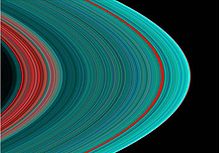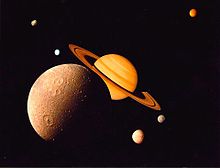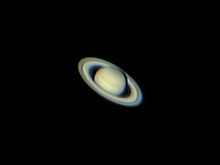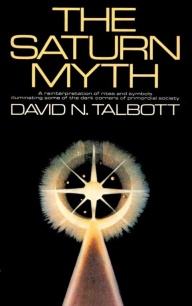
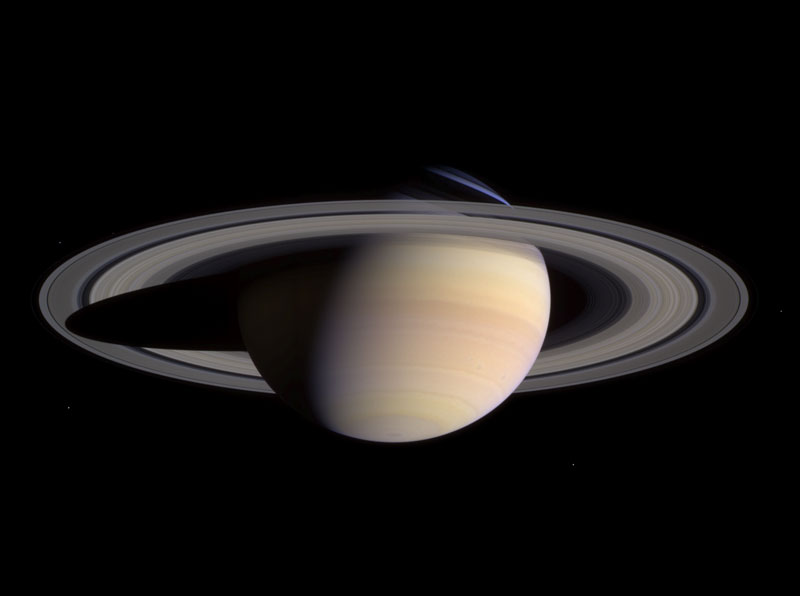 Polidoro
da Caravaggio -painting
THE PLANET SATURN - TAKEN BY CASSINI SATTELITE
Polidoro
da Caravaggio -painting
THE PLANET SATURN - TAKEN BY CASSINI SATTELITE
Dee Finney's blog
start date July 20, 2011
today's date May 24, 2013
page 506
TOPIC: THE SATURN - EARTH CONNECTION
5-12-13 There was a large, tall man standing at the corner of a large gold
plated structure such as a rectangle or square that was almost as tall and just
as wide, with a feature like balls in a cup in an even spaced grid system of
design.
What comes to mind is a cycle of time such as the Golden Age, and the 'ball
in the cup' is a design that even the aliens have presented in a crop circle.
Joe Mason explains that the 'Golden Age' is presided over by the God Saturn
who was the Father of Jupiter, in the Roman mythology.
On 5-24-13 - Dr. Bill Deagle quoted Dr. James McCanney as saying that we are
now in an Earth-Saturn electrical connection which is causing the bad weather we
are having.
www.greatdreams.com/crop/2006ccs/2006ccs2.htm
The half ring "cup" may represent the ancient "U"
symbol of the abyss, a deep hole, or valley. .... T-Tau rising to stand
in U-cup. --- ..... sperm circle ball in cup. ---
...
www.greatdreams.com/crop/777/july_7_07-eastfield.htm
Jul 7, 2007 ... The ball in the cup
appeared in Germany in 1991 at Grasdorf. ... I noticed last year that the
ancient "Om" symbol has a ball in the cup design: ...
-
www.greatdreams.com/numbers/888.htm
Postings in this thread included ideas about the
birth process, based on the “ sperm” and ball in the cup,
associated with the crop formation at Fife and the similar ...
en.wikipedia.org/wiki/Saturn_(mythology) -
Saturn (Latin: Saturnus) was a god in ancient
Roman religion and a character in myth. Saturn is a complex figure
because of his multiple associations and long ...
www.wyzant.com/help/english/etymology/planets/saturn
Saturn. Saturn, god of Harvest or Time
of Reaping (sixth planet from the Sun). Saturn, Roman god of the
harvest. Harvest time in ancient Italy belonged to the ...
-
www.gulfcoastacademy.org/tech/projects/08-09_student_web/AliviaD/god_of_agr...
The planet Saturn was named for the Roman God
Saturn who represented agriculture and fertility. He had one son,
his name was Jupiter. Jupiter is the planet ...
-
www.crystalinks.com/saturnrome.html
Saturn. In ancient Roman religion and myth,
Saturn (Latin: Saturnus) was a god of agriculture,
liberation, and time. His reign was depicted as a Golden Age of ...
-
www.windows2universe.org/mythology/Definitions_gods/Saturn_def....
-
The Romans adopted Cronus as the god Saturn.
... Neptune was the name that ancient Romans gave to the Greek
god of the sea and earthquakes, Poseidon.
-
www.britannica.com/EBchecked/topic/525167/Saturn -
In Roman religion, the god of sowing or
seed. The Romans equated him with the Greek agricultural deity Cronus.
The remains of Saturn's temple at Rome, eight ...
www.pantheon.org/articles/s/saturn.html -
Mar 3, 1997 ... The Roman god of agriculture
concerned with the sowing of the seeds. ... Saturn. In memory of
this Golden Age, each year the Saturnalia was ...
-
www.talesbeyondbelief.com/roman-gods/saturn.htm
Visit the Ancient world of the Roman god Saturn
(Saturnus). ... The legends and mythology about the Saturn the Roman
god of time, harvest and agriculture.
-
www.varchive.org/itb/satwor.htm
Before Jupiter (Zeus) became the chief god,
Saturn (Kronos) occupied the celestial throne. In all ancient religions
the dominion passes from Saturn to Jupiter.
-
avalon100.tripod.com/Saturn.html
Astrological Saturn has always been associated
with the letter of the law and Gnostics and Kabbalists have identified
Saturn with the god of Early Scripture, ...
-
beforeitsnews.com/power-elite/2012/02/occult-symbolism-saturn-worship-17210...
Feb 5, 2012 ... Semitic civilizations
referred to the god Saturn as “El”. The supreme deity was
represented by a black cube. We can find instances of the cube ...
-
en.wikipedia.org/wiki/Saturn_(mythology)
Saturn (Latin: Saturnus) was a god in
ancient Roman religion and a character in myth. ..... support on
the common people (plebs) rather than the senatorial elite.
-
illuminatiwatcher.com/?p=4673
Nov 29, 2012 ... So this means they had
outright Saturn gods, and also sun gods, some of ....
several entertainment outlets and also in wealthy elite families.
-
www.atlanteanconspiracy.com/2008/07/saturn-satan-and-666.html -
Oct 5, 2010 ... You're wearing God's
ring. And the yarmulke was the round ring that you wear on your head,
for Saturn your God. Even in the middle ages, ...
*********************
Beinsa Douno’s Last Prophecy of the Golden Age
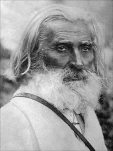
Ellie Miser sends along the last prophecy of Beinsa
Douno (Peter Deunov), which is of interest if you
remember that he died in 1944.
I’d imagine that many of the events he describes
here have come about through such things as HAARP. But
some of the events may also either be in our future or
not be slated to happen at all because of the degree to
which people have opened to the light. It isn’t
necessary for Gaia, I believe, to go through many
possible purification events if we divest ourselves of
negativity willingly.
The Divine Fire that the White Brotherhood master
refers to may be the Light that carries us to full
restoration. It may be the Light from the Source that
comes to us through the galactic Sun and our own local
Sun, Sol.
It isn’t literally a fire, I’m quite sure. So read
with an eye to applying his words to the events that
have actually occurred or will occur, but don’t draw
what he says he through a filter of hellfire and
catastrophe.
Beinsa Douno spoke about the New Age throughout most
of his career as a prophet so this is not by a long shot
the only piece he wrote about it. For me, its chief
significance lies in showing how many others saw clearly
the events that were coming within a short time of when
they wrote.
http://www.angelfire.com/oh2/peterr/ProphecyOfPeterDeunov.html
The last prophecy of Peter Deunov regarding
the end of our civilization and the beginning of the
Golden Age on earth.
Also known under the spiritual name of Beinsa Douno, the
Bulgarian Master Peter Deunov (1864-1944) was a being of
a very high level of consciousness, at the same time an
incomparable musician, that gave during his whole life
an example of purity, wisdom, intelligence and
creativity. For years he was established close to Sofia
where he lived surrounded by numerous disciples, he, by
his radiance awakened the spirituality of thousands of
souls in Bulgaria as well as the rest of Europe.
Some days before his departure to the other world, he
was in a profound mediumistic trance, he made an
extraordinary prophecy in regards to our troubled epoch
that we are crossing today, a prophecy about the “end of
time” and the coming of a new Golden Age of humanity.
Here is this deeply moving testament. It is current and
so vibrant that one doubts that these words were spoken
almost 60 years ago.
~=~ -:- ~=~ -:- ~=~ -:- ~>>-<>~+~<>-<<~ -:- ~=~ -:- ~=~
-:- ~=~
“During the passage of time, the consciousness of man
traversed a very long period of obscurity. This phase
which the Hindus call “Kali Yuga”, is on the verge of
ending. We find ourselves today at the frontier between
two epochs: that of Kali Yuga and that of the New Era
that we are entering.
A gradual improvement is already occurring in the
thoughts, sentiments and acts of humans, but everybody
will soon be subjugated to divine Fire, that will purify
and prepare them in regards to the New Era. Thus man
will raise himself to a superior degree of
consciousness, indispensable to his entrance to the New
Life. That is what one understands by “Ascension”.
Some decades will pass before this Fire will come, that
will transform the world by bringing it a new moral.
This immense wave comes from cosmic space and will
inundate the entire earth. All those that attempt to
oppose it will be carried off and transferred
elsewhere. Although the inhabitants of this planet do
not all find themselves at the same degree of evolution,
the new wave will be felt by each one of us. And this
transformation will not only touch the Earth, but the
ensemble of the entire Cosmos.
The best and only thing that man can do now is to turn
towards God and improve himself consciously, to elevate
his vibratory level, so as to find himself in harmony
with the powerful wave that will soon submerge him.
The Fire of which I speak, that accompanies the new
conditions offered to our planet, will rejuvenate,
purify, reconstruct everything: the matter will be
refined, your hearts will be liberated from anguish,
troubles, incertitude, and they will become luminous;
everything will be improved, elevated; the thoughts,
sentiments and negative acts will be consumed and
destroyed.
Your present life is a slavery, a heavy prison.
Understand your situation and liberate yourself from it.
I tell you this: exit from your prison! It is really
sorry to see so much misleading, so much suffering, so
much incapacity to understand where one’s true happiness
lies.
Everything that is around you will soon collapse and
disappear. Nothing will be left of this civilization nor
its perversity; the entire earth will be shaken and no
trace will be left of this erroneous culture that
maintains men under the yoke of ignorance. Earthquakes
are not only mechanical phenomena, their goal is also to
awaken the intellect and the heart of humans, so that
they liberate themselves from their errors and their
follies and that they understand that they are not the
only ones in the universe.
Our solar system is now traversing a region of the
Cosmos where a constellation that was destroyed left its
mark, its dust. This crossing of a contaminated space is
a source of poisoning, not only for the inhabitants of
the earth, but for all the inhabitants of the other
planets of our galaxy. Only the suns are not affected by
the influence of this hostile environment.
This region is called “the thirteenth zone”; one also
calls it “the zone of contradictions”. Our planet was
enclosed in this region for thousands of years, but
finally we are approaching the exit of this space of
darkness and we are on the point of attaining a more
spiritual region, where more evolved beings live.
The earth is now following an ascending movement and
everyone should force themselves to harmonize with the
currents of the ascension. Those who refuse to subjugate
themselves to this orientation will lose the advantage
of good conditions that are offered in the future to
elevate themselves. They will remain behind in evolution
and must wait tens of millions of years for the coming
of a new ascending wave.
The earth, the solar system, the universe, all are being
put in a new direction under the impulsion of Love. Most
of you still consider Love as a derisory force, but in
reality, it is the greatest of all forces! Money and
power continue to be venerated as if the course of your
life depended upon it. In the future, all will be
subjugated to Love and all will serve it. But it is
through suffering and difficulties that the
consciousness of man will be awakened.
The terrible predictions of the prophet Daniel written
in the bible relate to the epoch that is opening. There
will be floods, hurricanes, gigantic fires and
earthquakes that will sweep away everything. Blood will
flow in abundance. There will be revolutions; terrible
explosions will resound in numerous regions of the
earth. There where there is earth, water will come, and
there where there is water, earth will come.
God is Love; yet we are dealing here with a
chastisement, a reply by Nature against the crimes
perpetrated by man since the night of time against his
Mother; the Earth.
After these sufferings, those that will be saved, the
elite, will know the Golden Age, harmony and unlimited
beauty. Thus keep your peace and your faith when the
time comes for suffering and terror, because it is
written that not a hair will fall from the head of the
just. Don’t be discouraged, simply follow your work of
personal perfection.
You have no idea of the grandiose future that awaits
you. A New Earth will soon see day. In a few decades the
work will be less exacting, and each one will have the
time to consecrate spiritual, intellectual and artistic
activities. The question of rapport between man and
woman will be finally resolved in harmony; each one
having the possibility of following their aspirations.
The relations of couples will be founded on reciprocal
respect and esteem.
Humans will voyage through the different planes of space
and breakthrough intergalactic space. They will study
their functioning and will rapidly be able to know the
Divine World, to fusion with the Head of the Universe.
The New Era is that of the sixth race. Your
predestination is to prepare yourself for it, to welcome
it and to live it. The sixth race will build itself
around the idea of Fraternity. There will be no more
conflicts of personal interests; the single aspiration
of each one will be to conform himself to the Law of
Love. The sixth race will be that of Love. A new
continent will be formed for it. It will emerge from the
Pacific, so that the Most High can finally establish His
place on this planet.
The founders of this new civilization, I call them
“Brothers of Humanity” or also “Children of Love” They
will be unshakeable for the good and they will represent
a new type of men. Men will form a family, as a large
body, and each people will represent an organ in this
body. In the new race, Love will manifest in such a
perfect manner, that today’s man can only have a very
vague idea.
The earth will remain a terrain favorable to struggle,
but the forces of darkness will retreat and the earth
will be liberated from them. Humans seeing that there is
no other path will engage themselves to the path of the
New Life, that of salvation. In their senseless pride,
some will, to the end hope to continue on earth a life
that the Divine Order condemns, but each one will finish
by understanding that the direction of the world doesn’t
belong to them.
A new culture will see the light of day, it will rest on
three principal foundations: the elevation of woman, the
elevation of the meek and humble, and the protection of
the rights of man.
The light, the good, and justice will triumph; it is
just a question of time. The religions should be
purified. Each contains a particle of the Teaching of
the Masters of Light, but obscured by the incessant
supply of human deviation. All the believers will have
to unite and to put themselves in agreement with one
principal, that of placing Love as the base of all
belief, whatever it may be. Love and Fraternity that is
the common base!
The earth will soon be swept by extraordinary rapid
waves of Cosmic Electricity. A few decades from now
beings who are bad and lead others astray will not be
able to support their intensity. They will thus be
absorbed by Cosmic Fire that will consume the bad that
they possess. Then they will repent because it is
written that “each flesh shall glorify God”. Our
mother, the earth, will get rid of men that don’t accept
the New Life. She will reject them like damaged fruit.
They will soon not be able to reincarnate on this
planet; criminals included. Only those that possess Love
in them will remain.
There is not any place on earth that is not dirtied with
human or animal blood; she must therefore submit to a
purification. And it is for this that certain continents
will be immersed while others will surface.
Men do not suspect to what dangers they are menaced by.
They continue to pursue futile objectives and to seek
pleasure. On the contrary those of the sixth race will
be conscious of the dignity of their role and respectful
of each one’s liberty. They will nourish themselves
exclusively from products of the vegetal realm. Their
ideas will have the power to circulate freely as the air
and light of our days.
The words “If you are not born again.” apply to the
sixth race. Read Chapter 60 of Isaiah it relates to the
coming of the sixth race the Race of Love.
After the Tribulations, men will cease to sin and will
find again the path of virtue. The climate of our planet
will be moderated everywhere and brutal variations will
no longer exist. The air will once again become pure,
the same for water.
The parasites will disappear. Men will remember their
previous incarnations and they will feel the pleasure of
noticing that they are finally liberated from their
previous condition. In the same manner that one gets
rid of the parasites and dead leaves on the vine, so act
the evolved Beings to prepare men to serve the God of
Love.
They give to them good conditions to grow and to develop
themselves, and to those that want to listen to them,
they say: “Do not be afraid! Still a little more time
and everything will be all right; you are on the good
path. May he that wants to enter in the New Culture
study, consciously work and prepare.”
Thanks to the idea of Fraternity, the earth will become
a blessed place, and that will not wait. But before,
great sufferings will be sent to awaken the
consciousness. Sins accumulated for thousands of years
must be redeemed. The ardent wave emanating from On High
will contribute in liquidating the karma of peoples.
The liberation can no longer be postponed. Humanity must
prepare itself for great trials that are inescapable and
are coming to bring an end to egoism.
Under the earth, something extraordinary is
preparing itself. A revolution that is grandiose
and completely inconceivable will manifest itself soon
in nature. God has decided to redress the earth, and He
will do it!
It is the end of an epoch; a new order will substitute
the old, an order in which Love will reign on earth.”
=
Saturn (mythology)
Saturn (Latin:
Saturnus) was a
god in
ancient Roman religion and a character in
myth. Saturn is a complex figure because of his multiple
associations and long history. He was the first god of the Capitol,
known since the most ancient times as Saturnius Mons and was seen
as a god of generation, dissolution, plenty, wealth, agriculture,
periodical renewal and liberation. In later developments he came to be
also a god of time. His reign was depicted as a
Golden Age of abundance and peace. The
Temple of Saturn in the
Roman Forum housed the state treasury. In December, he was
celebrated at what is perhaps the most famous of the
Roman festivals, the
Saturnalia, a time of feasting, role reversals, free speech,
gift-giving and revelry.
Saturn
the planet and
Saturday are both named after the god.
Mythology of Saturn
The Romans identified Saturn with the Greek
Cronus, whose
myths were adapted for
Latin literature and
Roman art.
In particular, Cronus's role in the genealogy of the Greek gods was transferred
to Saturn. As early as
Livius Andronicus (3rd century BC),
Jupiter was called the son of Saturn.[1]
Saturn had two consorts who represented different aspects of the god. The
name of his wife Ops,
the Roman equivalent of Greek
Rhea, means "wealth, abundance, resources."[2]
The association with Ops though is considered a later development, as this
goddess was originally paired with
Consus.[3]
Earlier was Saturn's association with
Lua
("destruction, dissolution, loosening"), a goddess who received the bloodied
weapons of enemies destroyed in war.[4]
Under Saturn's rule, humans enjoyed the spontaneous bounty of the earth
without labor in a state of
social egalitarianism,[5]
in the "Golden Age" described by
Hesiod.
Etymology and epithets
According to
Varro,[6]
Saturn's name was derived from satu, "sowing." Even though this etymology
looks implausible on linguistic grounds (for the long quantity of the a
in Sāturnus and also because of the
epigraphically attested form Saeturnus)[7]
nevertheless it does reflect an original feature of the god.[8]
A more probable etymology connects the name with Etruscan god
Satre and placenames such as Satria, an ancient town of Latium,
and Saturae palus, a marsh also in Latium. This root may be related to
Latin phitonym satureia.[9]
Another epithet of his that referred to his agricultural functions was
Sterculius or Stercutus, Sterces[10]
from stercus, "manure."
Agriculture was important to Roman identity, and Saturn was a part of
archaic Roman religion and ethnic identity. His name appears in the ancient hymn
of the Salian priests,[who?]
and his temple was the oldest known to have been recorded by the
pontiffs.
Temple
The temple of Saturn was located at the base of the
Capitoline Hill, according to legend formerly known as Saturnius Mons,
and a row of columns from the last rebuilding of the temple still stand.[11]
The temple was consecrated in 497 BC but the area Saturni was built by
king
Tullus Hostilius as confirmed by archaeological studies conducted by E.
Gjerstad.[12]
It housed the state treasury (aerarium)
throughout Roman history.
Festival's time
The position of Saturn's festival in the
Roman calendar led to his association with concepts of time, especially the
temporal transition of the
New Year.
In the Greek tradition, Cronus was often conflated with
Chronus, "Time," and his devouring of his children taken as an allegory for
the passing of generations. The sickle or scythe of
Father
Time is a remnant of the agricultural implement of Cronus-Saturn, and his
aged appearance represents the waning of the old year with the birth of the new,
in antiquity sometimes embodied by
Aion.
In
late antiquity, Saturn is
syncretized
with a number of deities, and begins to be depicted as winged, as is
Kairos,
"Timing, Right Time".[13]
In Roman religion
Theology and worship
The figure of Saturn is one of the most complex and intriguing of Roman
religion.
G. Dumézil refrained from discussing Saturn in his work on Roman religion on
the grounds of our insufficient knowledge.[14]
On the contrary, his follower D. Briquel has attempted a thorough interpretation
of Saturn utilising
Dumézil's three-functional theory of Indoeuropean religion, taking the
ancient testimonies and the works of A. Brelich and G. Piccaluga as his basis.[15]
The main difficulty scholars find in studying Saturn is in assessing what is
original of his figure and what is due to later hellenising influences.
Moreover, some features of the god may be common to Cronus but are nonetheless
very ancient and can be considered proper to the Roman god, whereas other are
certainly later and arrived after 217 BC, year in which the Greek customs of the
Cronia were
introduced into the Saturnalia.[16]
Among the features which are definitely authentic of the Roman god, Briquel
identifies:
1. the time of his festival in the calendar, which corresponds to the date of
the consecration of his temple (the Greek Cronia on the other hand took place in
June-July);
2. his association with Lua Mater, and
3. the location of his cult on the Capitol, which goes back to remote times.[17]
These three elements in Briquel's view indicate that Saturn is a sovereign
god. The god's strict relationship with the cults of the Capitoline Hill and in
particular with Jupiter are highlighted by the legends concerning the refusal of
gods
Iuventas and
Terminus to leave their abode in the shrines on the Capitol when the temple
of Jupiter was to be built. These two deities correspond to the helper gods of
the sovereign in Vedic religion (Briquel refers to the figures of the
Mahabharata
Dhrtarastra and
Vidura) and to the
Cyclopes and
Hecatonchires in
Hesiod. Whereas
the helper gods belong to the second divine generation they become active only
at the level of the third in each of the three instances of India, Greece and
Rome, where they become a sort of continuation of Jupiter.
[18])
Dumézil postulated a split of the figure of the sovereign god in Indoeuropean
religion, which is embodied by Vedic gods
Varuna and
Mitra.[19]
Of the two, the first one shows the aspect of the magic, uncanny, awe inspiring
power of creation and destruction, while the second shows the reassuring aspect
of guarantor of the legal order in organised social life. Whereas in Jupiter
these double features have coalesced, Briquel sees Saturn as showing the
characters of a sovereign god of the
Varunian type. His nature becomes evident in his mastership over the annual
time of crisis around the winter solstice, epitomised in the power of subverting
normal codified social order and its rules, which is apparent in the festival of
the
Saturnalia, in the mastership on annual fertility and renewal, in the power
of annihilation present in his paredra Lua, in the fact that he is the god of a
timeless era of plenty and bounty before time, which he reinstates at the time
of the yearly crisis of the winter solstice. Also, in Roman and Etruscan
reckoning Saturn is a wielder of lightning; no other agricultural god (in the
sense of specialized human activity) is one.[20]
Hence the mastership he has on agriculture and wealth cannot be that of a god of
the third function, i.e. of production, wealth, and pleasure, but it stems from
his magical lordship over creation and destruction. Although these features are
to be found in Greek god Cronus as well, it looks they were proper to the most
ancient Roman representations of Saturn, such as his presence on the Capitol and
his association with Jupiter, who in the stories of the arrival of the
Pelasgians in the land of the
Sicels[21]
and that of the Argei
orders human sacrifices to him.[22]
Sacrifices to Saturn were performed according to "Greek rite" (ritus
graecus), with the head uncovered, in contrast to those of other major
Roman deities, which were performed
capite velato, "with the head covered." Saturn himself, however, was
represented as veiled (involutus), as for example in a wall painting from
Pompeii that
shows him holding a sickle and covered with a white veil. This feature is in
complete accord with the character of a sovereign god of the Varunian type and
is common with German god
Odin. Briquel
remarks
Servius had already seen that the choice of the Greek rite was due to the
fact that the god himself is imagined and represented as veiled, thence his
sacrifice cannot be carried out by a veiled man: this is an instance of the
reversal of the current order of things typical of the nature of the deity as
appears in its festival.[23]
Plutarch writes his figure is veiled because he is the father of truth.[24]
Pliny notes that the cult statue of Saturn was filled with oil; the exact
meaning of this is unclear.[25]
Its feet were bound with wool, which was removed only during the Saturnalia.[26]
The fact that the statue was filled with oil and the feet were bound with wool
may relate back to the myth of "The Castration of Uranus". In this myth Rhea
gives Cronus a rock to eat instead of Zeus thus tricking Cronus. Although
mastership of knots is a feature of Greek origin it is also typical of the
Varunian sovereign figure, as apparent e.g. in Odin. Once Zeus was victorious
over Cronus, he sets this stone up at Delphi and constantly it is anointed with
oil and strands of unwoven wool are placed on it.[27]
It wore a red cloak,[28]
and was brought out of the temple to take part in
ritual processions[29]
and
lectisternia, banquets at which images of the gods were arranged as
guests on couches.[11]
All these ceremonial details identify a sovereign figure. Briquel concludes that
Saturn was a sovereign god of a time that the Romans perceived as no longer
actual, that of the legendary origins of the world, before civilization.[30]
Little evidence exists in Italy for the cult of Saturn outside Rome, but his
name resembles that of the Etruscan god
Satres.[31]
The potential cruelty of Saturn was enhanced by his identification with
Cronus, known
for devouring his own children. He was thus equated with the Carthaginian god
Ba'al
Hammon, to whom children were sacrificed. Later this identification gave
rise to the African Saturn, a cult that enjoyed great popularity til the 4th
century. It had a popular but also a mysteric characters and required child
sacrifices. It is also considered as inclining to monotheism.[32]
In the ceremony of initiation the myste intrat sub iugum ritual that
Leglay compares also to the Roman tigillum sororium.[33]
Even though their origin and theology are completely different the Italic and
the African god are both sovereign and master over time and death, fact that has
permitted their encounter. Moreover here Saturn is not the real Italic god but
his Greek counterpart Cronus.
Saturn was also among the gods the Romans equated with
Yahweh, whose
Sabbath (on
Saturday) he shared as his holy day. The phrase Saturni dies, "Saturn's
day," first appears in Latin literature in a poem by
Tibullus,
who wrote during the reign of
Augustus.[34]
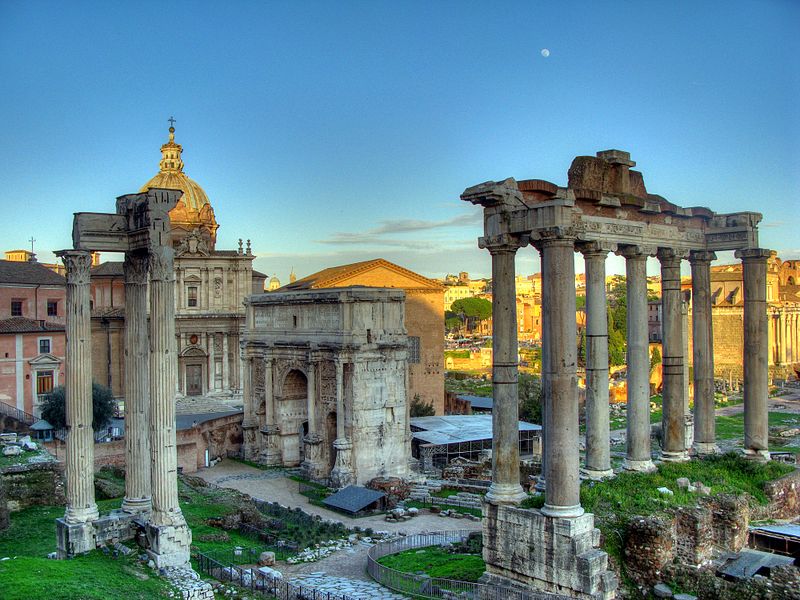
Saturnalia
Saturn is associated with a major religious festival in the Roman
calendar, Saturnalia. Saturnalia celebrated the harvest and sowing,
and ran from December 17–23. During Saturnalia, the social restrictions of
Rome were relaxed. The figure of Saturn, kept during the year with its legs
bound in wool, was released from its bindings for the period of the
festival.[26]
The revelries of Saturnalia were supposed to reflect the conditions of the
lost "Golden Age" before the rule of Saturn was overthrown, not all of them
desirable except as a temporary release from civilized constraint. The Greek
equivalent was the
Kronia.[35]
Macrobius (5th century AD) presents an interpretation of the Saturnalia
as a festival of light leading to the
winter solstice.[36]
The renewal of light and the coming of the new year was celebrated in the
later
Roman Empire at the Dies Natalis of
Sol
Invictus, the "Birthday of the Unconquerable Sun," on December 25.[37]
Roman legend of
Saturn
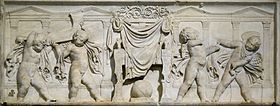
Relief held by the
Louvre thought to depict
the veiled throne of Saturn, either a Roman
work of the 1st century AD or a Renaissance copy
It was customary for the Romans to represent divine figures as kings of
Latium at the time of their legendary origins.
Macrobius states explicitly that the Roman legend of Janus and Saturn is
an affabulation, as the true meaning of religious beliefs cannot be openly
expressed.[38]
In the myth[39]
Saturn was the original and
autochthonous ruler of the
Capitolium, which had thus been called the Mons Saturnius in
older times and on which once stood the town of Saturnia.[40]
He was sometimes regarded as the first king of
Latium or
even the whole of Italy.[41]
At the same time, there was a tradition that Saturn had been an immigrant
god, received by
Janus after he was usurped by his son Jupiter and expelled from Greece.[42]
In Versnel's view his contradictions—a foreigner with one of Rome's oldest
sanctuaries, and a god of liberation who is kept in fetters most of the
year—indicate Saturn's capacity for obliterating social distinctions.[43]
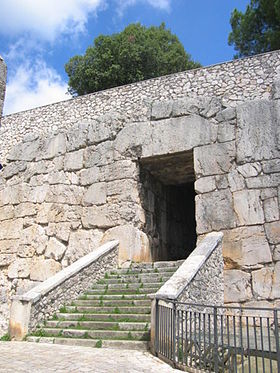
Alatri's main gate of the cyclopical walls
Roman mythology of the Golden Age of Saturn's reign differed from the
Greek tradition. He arrived in Italy "dethroned and fugitive,"[44]
but brought agriculture and civilization for which things was rewarded by
Janus with a share of the kingdom, becoming he himself king. As the Augustan
poet
Vergil described it, "He gathered together the unruly race" of
fauns and
nymphs
"scattered over mountain heights, and gave them laws … . Under his reign
were the golden ages men tell of: in such perfect peace he ruled the
nations."[45]
He was also said to have founded the five Saturnian towns of Latium:
Aletrium (today
Alatri), Anagnia (Anagni),
Arpinum (Arpino),
Atina and Ferentinum (Ferentino,
also known as Antinum) all located in present day
Ciociaria,
province of Frosinone. All these towns are surrounded by cyclopical walls;
their foundation is traditionally ascribed to the
Pelasgians.[46]
But Saturn also had a less benevolent aspect, as indicated by the blood
shed in his honor during gladiatorial munera. His consort in archaic
Roman tradition was
Lua, sometimes called Lua Saturni ("Saturn's Lua") and identified
with Lua Mater, "Mother Destruction," a goddess in whose honor the weapons
of enemies killed in war were burned, perhaps as expiation.[47]
H.S. Versnel, however, proposed that Lua Saturni should not be
identified with Lua Mater, but rather refers to "loosening"; she thus
represents the liberating function of Saturn.[48]
Gladiator munera
Saturn's
chthonic nature connected him to the underworld and its ruler
Dis Pater,
the Roman equivalent of Greek
Plouton (Pluto in Latin) who was also a god of hidden wealth.[49]
In 3rd-century AD sources and later, Saturn is recorded as receiving
gladiatorial offerings (munera) during or near the Saturnalia.[50]
These gladiator combats, ten days in all throughout December, were presented
by the
quaestors and sponsored with funds from the treasury of Saturn.[51]
The practice of gladiatorial munera was criticized by
Christian apologists as a form of human sacrifice.[52]
Although there is no evidence of this practice during the
Republican era, the offering of gladiators led to later theorizing that
the primeval Saturn had demanded human victims.
Macrobius
says that Dis Pater was placated with human heads and Saturn with
sacrificial victims consisting of men (virorum
victimis).[53]
The figurines that were exchanged as gifts (sigillaria)
during the Saturnalia may have represented token substitutes.[54]
On coins
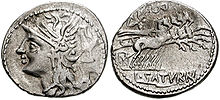
Saturn driving a
quadriga on the reverse
of a denarius issued by Saturninus
In 104 BC, the
plebeian
tribune
Lucius Appuleius Saturninus issued a
denarius
depicting Saturn driving a four-horse chariot (quadriga),
a vehicle associated with rulers,
triumphing generals, and
sun gods. Saturninus was a
popularist politician who had proposed reduced-price grain distribution
to the poor of Rome. The head of the
goddess Roma appears on the obverse. The Saturnian imagery played on the
tribune's name and his intent to subvert the
social hierarchy by basing his political support on the common people
(plebs)
rather than the senatorial elite.[55]
See also
References
-
^ Saturni filius,
frg. 2 in the edition of Baehrens.
-
^ Hans Friedrich
Mueller, "Saturn," Oxford Encyclopedia of Ancient Greece and Rome
(Oxford University Press, 2010), p. 222.
-
^ G. Dumézil p. 244.
-
^ G. Dumézil "Lua Mater"
in Déesses latines et mythes védiques Bruxelles 1968 1959 p.
98-115. D. compared this Roman figure with Indian deity Nírŗti.
-
^ Patricia A. Johnston,
"Saturnus and the Agricultural Golden Age," Vergil's Agricultural
Golden Age: A Study of Georgics, Leiden E. J. Brill (1980).
-
^
Varro, De lingua latina 5.64.
-
^ CIL I 2nd 449.
-
^ Briquel p. 144.
-
^ G. Alessio "Genti e
favelle dell' antica Apulia" Taranto Cressati 1949 = Archivio
Storico Pugliese 1949 II 1 p. 14.
-
^
Macrobius, Saturnalia 1.7.25.
-
^
a
b
Mueller, "Saturn," p. 222.
-
^ In Mélanges A.
Grenier Bruxelles 1962 p. 757-762 as cited by Briquel p. 141.
-
^ Samuel L. Macy, entry
on "Father Time," in Encyclopedia of Time (Taylor & Francis,
1994), pp. 208–209.
-
^ G. Dumézil La
religion romain archaïque Paris 1974 part I chap. 5; Italian
translation Milan 1977 p. 244-245.
-
^ D. Briquel "Jupiter,
Saturn et le Capitol. Essai de comparaison indoeuropéenne" in
Revue de l' histoire des religions 198 2 1981 p. 131-162.
A. Brelich Tre variazioni romane sul tema delle origini Roma
1956. G. Piccaluga Terminus Roma 1974.
-
^ Briquel 1981 pp. 142
ff.
-
^ Macrobius
Saturnalia I 7. Cited by Briquel above p. 143.
-
^ Iuventas shows a clear
Varunian character in the liaison of Romulus with the iuvenes
the young soldiers; Terminus has a Mitran character even though he
shows Varunian traits in allowing the enlargement of the borders (propagatio
finium): Briquel p. 134 n. 8.
-
^ G. Dumézil
Mitra-Varuna Paris 1940; Les dieux souverains des
Indo-Europééens Paris 1977.
-
^ Briquel p. 151 citing
Pliny II 138-139; Servius Ad Aeneidem I 42; XI 259. Saturn's
lightningbolts are those of wintertime.
-
^ Dionysius of
Halicarnassus Roman Anitiquities I 19 1; Macrobius
Saturnalia I 7 27-31
-
^ Ovid Fasti V
621-662, particularly 626-629.
-
^ Briquel p. 148 who
cites Servius Ad Aenaeidem III 407.
-
^ Briquel p. 148 n. 63
who cites Plutarch Quaestiones Romanae II.
-
^ Pliny, Natural
History 15.32.
-
^
a
b
Macrobius, Saturnalia 1.8.5.
-
^ Robert Graves, "The
Greek Myths: 1" page 41
-
^
Tertullian, De testimonio animae 2.
-
^
Dionysius of Halicarnassus, Antiquitates Romanae 7.72.13.
-
^ Briquel p. 155.
-
^ Found on the
Piacenza Liver; see also
Martianus Capella 1.58. Mueller, "Saturn," p. 222.
-
^ M. Leglay Saturn
africaine. Histoire Paris BEFRA 1966.
-
^ Leglay p. 385-386.
-
^ Mueller, "Saturn," p.
221.
-
^ William F. Hansen,
Ariadne's Thread: A Guide to International Tales Found in Classical
Literature (Cornell University Press, 2002), p. 385.
-
^
Macrobius, Saturnalia 1.1.8–9; Jane Chance, Medieval
Mythography: From Roman North Africa to the School of Chartres, A.D.
433–1177 (University Press of Florida, 1994), p. 71.
-
^ see Robert A. Kaster,
Macrobius: Saturnalia, Books 1–2 (Loeb
Classical Library, 2011), note on p. 16.
-
^ Macrobius
Saturnalia I 7, 18.
-
^ Macrobius Saturnalia
I, 9; Vergil Aeneis VII, 49
-
^ Varro Lingua Latina
V 42 and 45; Vergil Aeneis VIII 357-8; Dionysius of
Halicarnassus Roman Antiquities I 34; Festus p. 322 L;
Macrobius Sat. I 7, 27 and I 10, 4; Pliny the Elder
Natural History III 68; Minucius Felix Octavius 22;
Tertullian Apologeticum 10 as cited by Briquel p. 154.
-
^ Versnel, "Saturnus and
the Saturnalia," pp. 138–139.
-
^ Versnel, "Saturnus and
the Saturnalia," p. 139. The Roman theologian
Varro listed Saturn among the
Sabine gods.
-
^ Versnel, "Saturnus and
the Saturnalia," pp. 139, 142–143.
-
^ Versnel, "Saturnus and
the Saturnalia," p. 143.
-
^ Vergil,
Aeneid
8.320–325, as cited by Versnel, "Saturnus and the Saturnalia," p.
143.
-
^ Mario Pincherle,
Giuliana C. Volpi: La civiltà minoica in Italia. Le città
saturnie Pisa 1990 Pacini.
-
^ Mueller, "Saturn," in
The Oxford Encyclopedia of Ancient Greece and Rome, p. 222.
-
^ Versnel, "Saturnus and
the Saturnalia," p. 144.
-
^ H.S. Versnel,
"Saturnus and the Saturnalia," in Inconsistencies in Greek and
Roman Religion: Transition and Reversal in Myth and Ritual
(Brill, 1993, 1994), pp. 144–145. See also the
Etruscan god Satre.
-
^ For instance,
Ausonius, Eclogue 23 and De feriis Romanis 33–7.
See Versnel, "Saturnus and the Saturnalia," pp. 146 and 211–212, and
Thomas E.J. Wiedemann, Emperors and Gladiators (Routledge,
1992, 1995), p. 47.
-
^ Eight days were
subsidized from the Imperial treasury (arca fisci), and two
mostly by the sponsoring
magistrate himself; Michele Renee Salzman, On Roman Time: The
Codex-Calendar of 354 and the Rhythms of Urban Life in Late
Antiquity (University of California Press, 1990), p. 186.
-
^ Mueller, "Saturn," in
The Oxford Encyclopedia of Ancient Greece and Rome, p. 222;
Versnel, "Saturnus and the Saturnalia," p. 146.
-
^ Macrobius,
Saturnalia 1.7.31; Versnel, "Saturnus and the Saturnalia," p.
146.
-
^ Macrobius,
Saturnalia 1.10.24; Carlin A. Barton, The Sorrows of the
Ancient Romans: The Gladiator and the Monster (Princeton
University Press, 1993), p. 166. For other Roman practices that may
represent substitutes for human sacrifice, see
Argei
and
oscilla, the latter of which were used also at the
Latin Festival and the
Compitalia:
William Warde Fowler, The Roman Festivals of the Period of
the Republic (London, 1908), p. 272.
-
^ Versnel, "Saturnus and
the Saturnalia," p. 162.
Bibliography
- Georges Dumézil La religion romain archaïque Paris Payot 1974
2nd; Italian translation La religione romana arcaica Milano
Rizzoli 1977. Edizione e traduzione a cura di Furio Jesi.
- Dominique Briquel "Jupiter, Saturn et le Capitol. Essai de
comparaison indoeuropéenne" in Revue de l' histoire des religions
198 2. 1981 p. 131-162.
- Marcel Leglay Saturn africain. Histoire BEFAR Paris de
Boccard 1966.
- H.S. Versnel, "Saturnus and the Saturnalia," in Inconsistencies in
Greek and Roman Religion: Transition and Reversal in Myth and Ritual
(Brill, 1993, 1994), pp. 144–145.
Further reading
- Guirand, Felix (Editor); Aldington, Richard (Translator); Ames,
Delano (Translator); & Graves, Robert (Introduction). New Larousse
Encyclopedia of Mythology.
ISBN 0-517-00404-6
External links
|
|
|
|
Deities |
|
|
|
| Abstract deities |
|
|
| Legendary founders |
|
|
| Texts |
|
|
| Concepts and practices |
|
|
| See also |
|
|
Saturn is the sixth
planet from the
Sun and the second
largest planet in the
Solar
System, after
Jupiter. Named after the
Roman god of agriculture,
Saturn, its
astronomical symbol (♄) represents the god's
sickle. Saturn
is a gas
giant with an average radius about nine times that of
Earth.[10][11]
While only one-eighth the average density of Earth, with its larger volume
Saturn is just over 95 times more massive than Earth.[12][13][14]
Saturn's interior is probably composed of a core of iron, nickel and rock
(silicon and oxygen compounds), surrounded by a deep layer of
metallic hydrogen, an intermediate layer of
liquid hydrogen and
liquid helium and an outer gaseous layer.[15]
The planet exhibits a pale yellow hue due to ammonia crystals in its upper
atmosphere.
Electrical current within the metallic hydrogen layer is thought to give
rise to Saturn's planetary
magnetic field, which is slightly weaker than Earth's and around
one-twentieth the strength of Jupiter's.[16]
The outer
atmosphere is generally bland and lacking in contrast, although long-lived
features can appear.
Wind speeds
on Saturn can reach 1,800 km/h (1,100 mph), faster than on
Jupiter, but
not as fast as those on
Neptune.[17]
Saturn has a prominent
ring system that consists of nine continuous main rings and three
discontinuous arcs, composed mostly of ice particles with a smaller amount of
rocky debris and
dust.
Sixty-two[18]
known
moons orbit the planet; fifty-three are officially named. This does not
include the hundreds of "moonlets"
within the rings.
Titan,
Saturn's largest and the Solar System's second largest moon, is larger than the
planet
Mercury and is the only moon in the Solar System to retain a substantial
atmosphere.[19]
Saturn is classified as a
gas giant
planet because the exterior is predominantly composed of gas and it lacks a
definite surface, although it may have a solid core.[20]
The rotation of the planet causes it to take the shape of an
oblate spheroid; that is, it is flattened at the poles and bulges at the
equator. Its equatorial and polar radii differ by almost 10% — 60,268 km versus
54,364 km, respectively.[3]
Jupiter, Uranus,
and Neptune,
the other gas giants in the Solar System, are also oblate but to a lesser
extent. Saturn is the only planet of the Solar System that is less dense than
water — about 30% less.[21]
Although Saturn's
core is considerably denser than water, the average
specific density of the planet is 0.69 g/cm3 due to the gaseous
atmosphere. Jupiter has 318 times the Earth's mass,[22]
while Saturn is 95 times the mass of the
Earth,[3]
Together, Jupiter and Saturn hold 92% of the total planetary mass in the Solar
System.[23]
Internal structure
Saturn is termed a gas giant, but it is not entirely gaseous. The planet
primarily consists of hydrogen, which becomes a
non-ideal liquid when the density is above 0.01 g/cm3. This
density is reached at a radius containing 99.9% of Saturn's mass. The
temperature, pressure and density inside the planet all rise steadily toward the
core, which, in the deeper layers of the planet, cause hydrogen to transition
into a metal.[23]
Standard planetary models suggest that the interior of Saturn is similar to
that of Jupiter,
having a small rocky core surrounded by
hydrogen
and helium with
trace amounts of various
volatiles.[24]
This core is similar in composition to the Earth, but more dense. Examination of
the
gravitational moment of the planet, in combination with physical models of
the interior, allowed French astronomers Didier Saumon and Tristan Guillot to
place constraints on the mass of the planet's core. In 2004, they estimated that
the core must be 9–22 times the mass of the Earth,[25][26]
which corresponds to a diameter of about 25,000 km.[27]
This is surrounded by a thicker liquid
metallic hydrogen layer, followed by a liquid layer of helium-saturated
molecular hydrogen that gradually transitions into gas with increasing
altitude. The outermost layer spans 1,000 km and consists of a gaseous
atmosphere.[28][29][30]
Saturn has a very hot interior, reaching 11,700 °C at the core, and the
planet radiates 2.5 times more energy into space than it receives from the Sun.
Most of this extra energy is generated by the
Kelvin–Helmholtz mechanism of slow gravitational compression, but this alone
may not be sufficient to explain Saturn's heat production. An additional
mechanism may be at play whereby Saturn generates some of its heat through the
"raining out" of droplets of helium deep in its interior. As the droplets
descend through the lower-density hydrogen, the process releases heat by
friction
and leaves the outer layers of the planet depleted of helium.[31][32]
These descending droplets may have accumulated into a helium shell surrounding
the core.[24]
Atmosphere
The outer atmosphere of Saturn contains 96.3% molecular hydrogen and 3.25%
helium.[33]
The proportion of helium is significantly deficient compared to the abundance of
this element in the Sun.[24]
The quantity of elements heavier than helium are not known precisely, but the
proportions are assumed to match the primordial abundances from the formation of
the Solar System. The total mass of these heavier elements is estimated to be
19–31 times the mass of the Earth, with a significant fraction located in
Saturn's core region.[34]
Trace amounts of
ammonia,
acetylene,
ethane,
propane,
phosphine
and methane
have been detected in Saturn's atmosphere.[35][36][37]
The upper clouds are composed of ammonia crystals, while the lower level clouds
appear to consist of either
ammonium hydrosulfide (NH4SH) or water.[38]
Ultraviolet radiation from the Sun causes methane
photolysis in the upper atmosphere, leading to a series of hydrocarbon
chemical reactions with the resulting products being carried downward by eddies
and diffusion. This photochemical cycle is modulated by Saturn's annual seasonal
cycle.[37]
Cloud layers
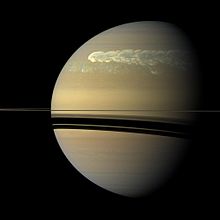
A global storm girdles the planet in 2011.
The head of the storm (bright area) passes
the tail circling around the left limb.
Saturn's atmosphere exhibits a banded pattern similar to Jupiter's, but
Saturn's bands are much fainter and are much wider near the equator. The
nomenclature used to describe these bands is the same as on Jupiter.
Saturn's finer cloud patterns were not observed until the flybys of the
Voyager spacecraft during the 1980s.
Since then, Earth-based
telescopy
has improved to the point where regular observations can be made.[39]
The composition of the clouds varies with depth and increasing pressure. In
the upper cloud layers, with the temperature in the range 100–160 K and
pressures extending between 0.5–2 bar, the clouds consist of ammonia ice. Water
ice clouds begin at a level where the pressure is about 2.5 bar and extend down
to 9.5 bar, where temperatures range from 185–270 K. Intermixed in this layer is
a band of ammonium hydrosulfide ice, lying in the pressure range 3–6 bar with
temperatures of 290–235 K. Finally, the lower layers, where pressures are
between 10–20 bar and temperatures are 270–330 K, contains a region of water
droplets with ammonia in aqueous solution.[40]
Saturn's usually bland atmosphere occasionally exhibits long-lived ovals and
other features common on Jupiter. In 1990, the
Hubble Space Telescope imaged an enormous white cloud near Saturn's equator
that was not present during the Voyager encounters and in 1994, another, smaller
storm was observed. The 1990 storm was an example of a
Great White Spot, a unique but short-lived phenomenon that occurs once every
Saturnian year, roughly every 30 Earth years, around the time of the northern
hemisphere's
summer solstice.[41]
Previous Great White Spots were observed in 1876, 1903, 1933 and 1960, with the
1933 storm being the most famous. If the periodicity is maintained, another
storm will occur in about 2020.[42]
The winds on Saturn are the second fastest among the Solar System's planets.
Voyager data indicate peak easterly winds of 500 m/s (1800 km/h).[43]
In images from the
Cassini spacecraft during 2007, Saturn's northern hemisphere displayed a
bright blue hue, similar to Uranus. The color was most likely caused by
Rayleigh scattering.[44]
Infrared
imaging has shown that Saturn's south pole has a warm
polar
vortex, the only known example of such a phenomenon in the Solar System.[45]
Whereas temperatures on Saturn are normally −185 °C, temperatures on the vortex
often reach as high as −122 °C, believed to be the warmest spot on Saturn.[45]
North pole
hexagonal cloud pattern
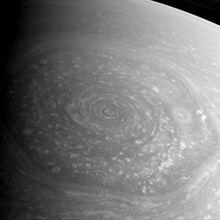
North polar hexagonal cloud feature, discovered by
Voyager 1 and confirmed in 2006 by
Cassini.
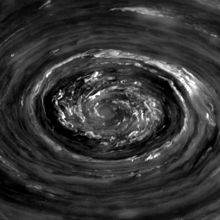
Closer view of the north polar vortex at the center of the hexagon
A persisting
hexagonal wave pattern around the north polar vortex in the atmosphere at
about 78°N was first noted in the Voyager images.[46][47]
The straight sides of the northern polar hexagon are each approximately
13,800 km (8,600 mi) long, making them larger than the diameter of the Earth.[48]
The entire structure rotates with a period of 10h 39m 24s
(the same period as that of the planet's radio emissions) which is assumed to be
equal to the period of rotation of Saturn's interior.[49]
The hexagonal feature does not shift in longitude like the other clouds in the
visible atmosphere.[50]
The pattern's origin is a matter of much speculation. Most astronomers
believe it was caused by some standing-wave pattern in the atmosphere. Polygonal
shapes have been replicated in the laboratory through differential rotation of
fluids.[51][52
South pole vortex
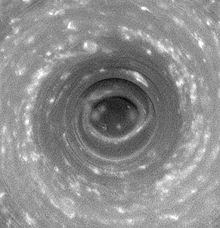
Saturn's south pole storm
HST imaging of the south polar region indicates the presence of a
jet stream,
but no strong polar vortex nor any hexagonal standing wave.[53]
NASA reported in
November 2006 that Cassini had observed a "hurricane-like"
storm locked to the south pole that had a clearly defined
eyewall.[54][55]
This observation is particularly notable because eyewall clouds had not
previously been seen on any planet other than Earth. For example, images from
the
Galileo spacecraft did not show an eyewall in the
Great Red Spot of Jupiter.[56]
The south pole storm may have been present for billions of years.[57]
This vortex is comparable to the size of Earth, and it has winds of 550 kph.[57]
Other features
Cassini has observed a series of cloud features nicknamed "String of Pearls"
found in northern latitudes. These features are cloud clearings that reside in
deeper cloud layers.[58]
Magnetosphere
.jpg)
HST
UV image of Saturn taken near equinox showing both polar
aurorae.
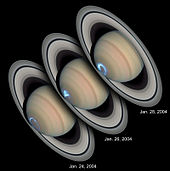
Hubble's STIS ultraviolet and
ACS visible light combine to reveal
Saturn's southern aurora.
Saturn has an intrinsic
magnetic field that has a simple, symmetric shape – a magnetic
dipole. Its
strength at the equator – 0.2 gauss
(20 µT)
– is approximately one twentieth of that of the field around Jupiter and
slightly weaker than Earth's
magnetic field.[16]
As a result Saturn's
magnetosphere is much smaller than Jupiter's.[59]
When Voyager 2 entered the magnetosphere, the
solar wind
pressure was high and the magnetosphere extended only 19 Saturn radii, or 1.1
million km (712,000 mi),[60]
although it enlarged within several hours, and remained so for about three days.[61]
Most probably, the magnetic field is generated similarly to that of Jupiter – by
currents in the liquid metallic-hydrogen layer called a metallic-hydrogen
dynamo.[59]
This magnetosphere is efficient at deflecting the
solar wind
particles from the Sun.
The moon Titan orbits within the outer part of Saturn's magnetosphere and
contributes plasma from the
ionized particles in
Titan's outer atmosphere.[16]
Saturn's magnetosphere, like
Earth's, produces
aurorae.[62]
Orbit and rotation
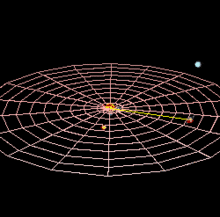
The average distance between Saturn and the
Sun is
over
1.4×109 km (9 AU). It takes Saturn
10,759 Earth days (or about
29 1⁄2
Earth years), to finish one revolution around the Sun.
The average distance between Saturn and the
Sun is over 1.4
billion kilometres (9
AU). With an average orbital speed of 9.69 km/s,[3]
it takes Saturn 10,759 Earth days (or about 29½ years),[63]
to finish one revolution around the Sun.[3]
The elliptical orbit of Saturn is inclined 2.48° relative to the orbital plane
of the Earth.[3]
Because of an
eccentricity of 0.056, the distance between Saturn and the Sun varies by
approximately 155 million kilometres between
perihelion and
aphelion,[3]
which are the nearest and most distant points of the planet along its orbital
path, respectively.
The visible features on Saturn rotate at different rates depending on
latitude and multiple rotation periods have been assigned to various regions (as
in Jupiter's case): System I has a period of 10 h 14 min 00 s (844.3°/d)
and encompasses the Equatorial Zone, which extends from the northern edge of the
South Equatorial Belt to the southern edge of the North Equatorial Belt. All
other Saturnian latitudes have been assigned a rotation period of 10 h 38 min
25.4 s (810.76°/d), which is System II. System III, based on
radio emissions from the planet in the period of the Voyager flybys, has a
period of 10 h 39 min 22.4 s (810.8°/d); because it is very close to System II,
it has largely superseded it.[64]
A precise value for the rotation period of the interior remains elusive.
While approaching Saturn in 2004, Cassini found that the radio rotation
period of Saturn had increased appreciably, to approximately 10 h 45 m 45 s
(± 36 s).[65][66]
In March 2007, it was found that the variation of radio emissions from the
planet did not match Saturn's rotation rate. This variance may be caused by
geyser activity on Saturn's moon
Enceladus. The water vapor emitted into Saturn's orbit by this activity
becomes charged and creates a drag upon Saturn's magnetic field, slowing its
rotation slightly relative to the rotation of the planet.[67][68][68]
The latest estimate of Saturn's rotation based on a compilation of various
measurements from the Cassini, Voyager and Pioneer probes
was reported in September 2007 is 10 hours, 32 minutes, 35 seconds.[69]
Planetary rings
[edit]
Saturn is probably best known for the system of
planetary rings that makes it visually unique.[29]
The rings extend from 6,630 km to 120,700 km above Saturn's equator, average
approximately 20 meters in thickness and are composed of 93% water ice with
traces of tholin
impurities and 7% amorphous
carbon.[70]
The particles that make up the rings range in size from specks of dust up to
10 m.[71]
While the other
gas giants
also have ring systems, Saturn's is the largest and most visible. There are two
main hypotheses regarding the origin of the rings. One hypothesis is that the
rings are remnants of a destroyed moon of Saturn. The second hypothesis is that
the rings are left over from the original
nebular
material from which Saturn formed. Some ice in the central rings comes from the
moon Enceladus's ice volcanoes.[72]
In the past, astronomers believed the rings formed alongside the planet when it
formed billions of years ago.[73]
Instead, the age of these planetary rings is probably some hundreds of millions
of years.[74]
Beyond the main rings at a distance of 12 million km from the planet is the
sparse Phoebe ring, which is tilted at an angle of 27° to the other rings and,
like
Phoebe, orbits in
retrograde fashion.[75]
Some of the moons of Saturn, including
Pandora and
Prometheus, act as shepherd moons to confine the rings and prevent them from
spreading out.[76]
Pan and
Atlas
cause weak, linear density waves in Saturn's rings that have yielded more
reliable calculations of their masses.[77]
Natural satellites
[edit]
Saturn has at least 62
moons, 53 of which have formal names.[78]
Titan,
the largest, comprises more than 90% of the mass in orbit around Saturn,
including the rings.[79]
Saturn's second largest moon,
Rhea,
may have a tenuous
ring
system of its own,[80]
along with a tenuous
atmosphere.[81][82][83][84]
Many of the other moons are very small: 34 are less than 10 km in diameter and
another 14 less than 50 km but larger then 10 km.[85]
Traditionally, most of Saturn's moons have been named after
Titans of Greek mythology. Titan is the only satellite in the
Solar
System with a major
atmosphere[86][87]
in which a complex organic chemistry occurs. It is the only satellite with
hydrocarbon lakes.[88][89]
Saturn's moon
Enceladus has often been regarded as a potential base for microbial life.[90][91][92][93]
Evidence of this life includes the satellite's salt-rich particles having an
"ocean-like" composition that indicates most of Enceladus's expelled
ice comes from the
evaporation of liquid salt water.[94][95][96]
History of exploration
There have been three main phases in the observation and exploration of
Saturn. The first era was ancient observations (such as with the
naked eye),
before the invention of the modern telescopes. Starting in the 17th century
progressively more advanced telescopic observations from earth have been made.
The other type is visitation by spacecraft, either by orbiting or flyby. In the
21st century observations continue from the earth (or earth-orbiting
observatories) and from the Cassini orbiter at Saturn.
Ancient observations
Saturn has been known since prehistoric times.[97]
In ancient times, it was the most distant of the five known planets in the solar
system (excluding Earth) and thus a major character in various mythologies.
Babylonian astronomers systematically observed and recorded the movements of
Saturn.[98]
In
ancient Roman mythology, the god
Saturnus, from which the planet takes its name, was the god of agriculture.[99]
The Romans considered Saturnus the equivalent of the
Greek god
Cronus.[99]
The Greeks had made the outermost planet sacred to Cronus,[100]
and the Romans followed suit. (In modern
Greek, the planet retains its ancient name Cronus (Κρόνος: Kronos).)[101]
Ptolemy, a
Greek living in
Alexandria,[102]
observed an opposition of Saturn, which was the basis for his determination of
the elements of its orbit.[103]
In
Hindu astrology, there are nine astrological objects, known as
Navagrahas.
Saturn, one of them, is known as "Shani",
judges everyone based on the good and bad deeds performed in life.[99]
Ancient
Chinese and Japanese culture designated the planet Saturn as the earth
star (土星). This was based on
Five Elements which were traditionally used to classify natural elements.[104]
In ancient
Hebrew, Saturn is called 'Shabbathai'.[105]
Its angel is
Cassiel. Its intelligence or beneficial spirit is
Agiel (layga) and
its spirit (darker aspect) is Zazel (lzaz). In
Ottoman Turkish,
Urdu and
Malay, its name is 'Zuhal', derived from
Arabic زحل.
European observations (17th–19th centuries)
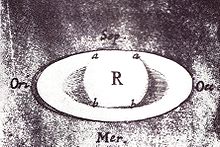
Robert Hooke noted the shadows
(a and b) cast by both the globe
and the rings on each other in this
drawing of Saturn in 1666.
Saturn's rings require at least a 15-mm-diameter
telescope[106]
to resolve and thus were not known to exist until
Galileo first saw them in 1610.[107][108]
He thought of them as two moons on Saturn's sides.[109][110]
It was not until
Christian Huygens used greater telescopic magnification that this notion was
refuted. Huygens discovered Saturn's moon Titan;
Giovanni Domenico Cassini later discovered four other moons:
Iapetus,
Rhea,
Tethys and
Dione.
In 1675, Cassini discovered the gap now known as the Cassini Division.[111]
No further discoveries of significance were made until 1789 when
William Herschel discovered two further moons,
Mimas
and
Enceladus. The irregularly shaped satellite
Hyperion, which has a
resonance with Titan, was discovered in 1848 by a British team.[112]
In 1899
William Henry Pickering discovered
Phoebe, a highly
irregular satellite that does not rotate synchronously with Saturn as the
larger moons do.[112]
Phoebe was the first such satellite found and it takes more than a year to orbit
Saturn in a
retrograde orbit. During the early 20th century, research on Titan led to
the confirmation in 1944 that it had a thick atmosphere – a feature unique among
the solar system's moons.[113]
Modern NASA and
ESA probes
Pioneer 11 flyby
Pioneer 11 carried out the first flyby of Saturn in September 1979, when
it passed within 20,000 km of the planet's cloud tops. Images were taken of the
planet and a few of its moons, although their resolution was too low to discern
surface detail. The spacecraft also studied Saturn's rings, revealing the thin
F-ring and the fact that dark gaps in the rings are bright when viewed at high
phase angle (towards the sun), meaning that they contain fine
light-scattering material. In addition, Pioneer 11 measured the
temperature of Titan.[114]
Voyager flybys
In November 1980, the
Voyager 1
probe visited the Saturn system. It sent back the first high-resolution images
of the planet, its rings and satellites. Surface features of various moons were
seen for the first time. Voyager 1 performed a close flyby of Titan,
increasing knowledge of the atmosphere of the moon. It proved that Titan's
atmosphere is impenetrable in visible wavelengths; so, no surface details were
seen. The flyby changed the spacecraft's trajectory out from the plane of the
solar system.[115]
Almost a year later, in August 1981,
Voyager 2
continued the study of the Saturn system. More close-up images of Saturn's moons
were acquired, as well as evidence of changes in the atmosphere and the rings.
Unfortunately, during the flyby, the probe's turnable camera platform stuck for
a couple of days and some planned imaging was lost. Saturn's gravity was used to
direct the spacecraft's trajectory towards Uranus.[115]
The probes discovered and confirmed several new satellites orbiting near or
within the planet's rings, as well as the small
Maxwell Gap (a gap within the
C Ring) and
Keeler gap (a 42 km wide gap in the
A Ring).
Cassini–Huygens spacecraft
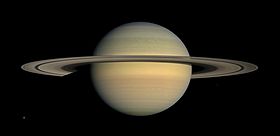
Saturn during equinox imaged by the
Cassini orbiter
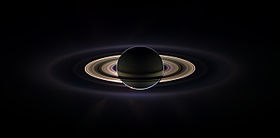
Saturn eclipses the Sun, as seen from
Cassini.
On July 1, 2004, the
Cassini–Huygens
space
probe performed the SOI (Saturn Orbit Insertion) maneuver and entered into
orbit around Saturn. Before the SOI, Cassini had already studied the
system extensively. In June 2004, it had conducted a close flyby of
Phoebe, sending back high-resolution images and data.
Cassini's flyby of Saturn's largest moon, Titan, has captured radar
images of large lakes and their coastlines with numerous islands and mountains.
The orbiter completed two Titan flybys before releasing the
Huygens probe on December 25, 2004. Huygens descended onto the surface of
Titan on January 14, 2005, sending a flood of data during the atmospheric
descent and after the landing.[116]
Cassini has since conducted multiple flybys of Titan and other icy
satellites.
Since early 2005, scientists have been tracking lightning on Saturn. The
power of the lightning is approximately 1,000 times that of lightning on Earth.[117]
In 2006, NASA reported that Cassini had found evidence of liquid water
reservoirs that erupt in
geysers on
Saturn's moon
Enceladus. Images had shown jets of icy particles being emitted into orbit
around Saturn from vents in the moon's south polar region. According to Andrew
Ingersoll, California Institute of Technology, "Other moons in the solar system
have liquid-water oceans covered by kilometers of icy crust. What's different
here is that pockets of liquid water may be no more than tens of meters below
the surface."[118]
In May 2011, NASA scientists at an Enceladus Focus Group Conference reported
that Enceladus "is emerging as the most habitable spot beyond Earth in the Solar
System for life as we know it".[119][120]
Cassini photographs have led to other significant discoveries. They
have revealed a previously undiscovered planetary ring, outside the brighter
main rings of Saturn and inside the G and E rings. The source of this ring is
believed to be the crashing of a meteoroid off two of the moons of Saturn.[121]
In July 2006, Cassini images provided evidence of hydrocarbon lakes near
Titan's north pole, the presence of which were confirmed in January 2007. In
March 2007, additional images near Titan's north pole revealed hydrocarbon
"seas", the largest of which is almost the size of the
Caspian
Sea.[122]
In October 2006, the probe detected a 8,000 km diameter cyclone-like storm with
an eyewall at Saturn's south pole.[123]
From 2004 to November 2, 2009, the probe discovered and confirmed 8 new
satellites. Its primary mission ended in 2008 when the spacecraft had completed
74 orbits around the planet. The probe's mission was extended to September 2010
and then extended again to 2017, to study a full period of Saturn's seasons.[124]
In April 2013 Cassini sent back images of a hurricane at the planet's north
pole 20 times larger than those found on Earth, with winds faster than 530km/h.[125]
Observation
Saturn is the most distant of the five planets easily visible to the naked
eye, the other four being
Mercury, Venus,
Mars and Jupiter
(Uranus and occasionally
4 Vesta are
visible to the naked eye in very dark skies). Saturn appears to the naked eye in
the night sky as a bright, yellowish point of light whose
apparent magnitude is usually between +1 and 0. It takes approximately
29½ years to make a complete circuit of the
ecliptic
against the background constellations of the
zodiac. Most
people will require optical aid (large binoculars or a telescope) magnifying at
least 20× to clearly resolve Saturn's rings.[29][106]
While it is a rewarding target for observation for most of the time it is
visible in the sky, Saturn and its rings are best seen when the planet is at or
near
opposition (the configuration of a planet when it is at an
elongation of 180° and thus appears opposite the Sun in the sky). During the
opposition of December 17, 2002, Saturn appeared at its brightest due to a
favorable
orientation of its rings relative to the Earth,[126]
even though Saturn was closer to the Earth and Sun in late 2003.[126]
In culture
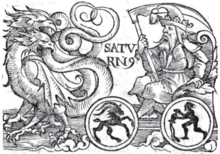
Saturn, from a 1550 edition of
Guido Bonatti's
Liber astronomiae.
See also
-
^
Orbital elements refer to the barycenter of
the Saturn system and are the instantaneous
osculating values at the precise
J2000 epoch. Barycenter quantities are given because, in contrast to
the planetary centre, they do not experience appreciable changes on a
day-to-day basis from the motion of the moons.
- ^
a
b
c
d
e
f
g
h Refers to the
level of 1 bar atmospheric pressure
References
[edit]
-
^
Walter,
Elizabeth (April 21, 2003). Cambridge Advanced Learner's Dictionary
(Second ed.). Cambridge University Press.
ISBN 978-0-521-53106-1.
-
^
Seligman,
Courtney.
"Rotation Period and Day Length".
Archived from the original on 2011-08-10.
Retrieved 2009-08-13.
- ^
a
b
c
d
e
f
g
h
i
j
k
l
m
n
o
p
q
r
s
Williams, David R. (September 7, 2006).
"Saturn Fact Sheet". NASA.
Archived from the original on 2011-08-21.
Retrieved 2007-07-31.
-
^
"The MeanPlane (Invariable plane) of the Solar System passing through
the barycenter". 2009-04-03.
Archived from the original on 2009-05-14.
Retrieved 2009-04-10.
(produced with
Solex 10 written by Aldo Vitagliano; see also
Invariable plane)
-
^
Yeomans, Donald
K. (2006-07-13).
"HORIZONS Web-Interface for Saturn Barycenter (Major Body=6)".
JPL Horizons On-Line Ephemeris System.
Retrieved 2007-08-08.
– At the site, go to the "web interface" then select "Ephemeris Type:
ELEMENTS", "Target Body: Saturn Barycenter" and "Center: Sun".
-
^
a
b
c
d
Seidelmann, P. Kenneth; Archinal, B. A.; A'hearn, M. F. et al. (2007).
"Report of the IAU/IAG Working Group on cartographic coordinates and
rotational elements: 2006". Celestial Mechanics and Dynamical
Astronomy 98 (3): 155–180.
Bibcode:2007CeMDA..98..155S.
doi:10.1007/s10569-007-9072-y.
edit
-
^
"NASA: Solar System Exploration: Planets: Saturn: Facts & Figures".
Solarsystem.nasa.gov. 2011-03-22.
Archived from the original on 2011-10-05.
Retrieved 2011-08-08.
-
^
'Astronews' (New Spin For Saturn).
Astronomy. November 2009. p. 23.
-
^
Schmude,
Richard W. Junior (2001).
"Wideband photoelectric magnitude measurements of Saturn in 2000".
Georgia Journal of Science. Archived from
the original on 2007-10-16.
Retrieved 2007-10-14.
-
^
Brainerd, Jerome
James (November 24, 2004).
"Characteristics of Saturn". The Astrophysics Spectator.
Archived from the original on 2011-10-05.
Retrieved 2010-07-05.
-
^
"General Information About Saturn". Scienceray. July 28,
2011.
Archived from the original on 2011-10-05.
Retrieved 2011-08-17.
-
^
Brainerd, Jerome
James (October 6, 2004).
"Solar System Planets Compared to Earth". The Astrophysics
Spectator.
Archived from the original on 2011-10-05.
Retrieved 2010-07-05.
-
^
Dunbar, Brian
(November 29, 2007).
"NASA – Saturn". NASA.
Archived from the original on 2011-10-05.
Retrieved 2011-07-21.
-
^
Cain, Fraser
(July 3, 2008).
"Mass of Saturn". Universe Today.
Retrieved 2011-08-17.
-
^
Brainerd, Jerome James (October 27, 2004).
"Giant Gaseous Planets". The Astrophysics Spectator.
Archived from the original on 2011-10-05.
Retrieved 2010-07-05.
- ^
a
b
c
Russell, C. T.; Luhmann, J. G. (1997).
"Saturn: Magnetic Field and Magnetosphere". UCLA – IGPP Space
Physics Center.
Archived from the original on 2011-10-05.
Retrieved 2007-04-29.
-
^
"The Planets ('Giants')".
Science Channel. June 8, 2004.
-
^
Piazza, Enrico.
"Saturn's Moons". Cassini, Equinox Mission. JPL NASA.
Archived from the original on 2011-10-05.
Retrieved 2010-06-22.
-
^
Munsell, Kirk
(April 6, 2005).
"The Story of Saturn". NASA Jet Propulsion Laboratory; California
Institute of Technology.
Archived from the original on 2011-08-22.
Retrieved 2007-07-07.
-
^
Melosh, H. Jay
(2011).
Planetary Surface Processes. Cambridge Planetary Science
13. Cambridge University Press. p. 5.
ISBN 0-521-51418-5.
-
^
"Saturn – The Most Beautiful Planet of our solar system".
Preserve Articles. January 23, 2011.
Archived from the original on 2011-10-05.
Retrieved 2011-07-24
-
^
Williams, David R. (November 16, 2004).
Jupiter Fact Sheet. NASA.
Archived from the original on 2011-10-0.
Retrieved 2007-08-02
- ^
a
b
Fortney, Jonathan J.; Nettelmann, Nadine
(May 2010). "The Interior Structure, Composition, and Evolution of Giant
Planets". Space Science Reviews 152 (1–4): 423–447.
arXiv:0912.0533.
Bibcode:2010SSRv..152..423F.
doi:10.1007/s11214-009-9582-x
- ^
a
b
c
Guillot, Tristan et al. (2009). "Saturn's
Exploration Beyond Cassini-Huygens". In Dougherty, Michele K.; Esposito,
Larry W.; Krimigis, Stamatios M.,. Saturn from Cassini-Huygens.
Springer Science+Business Media B.V. p. 745.
arXiv:0912.2020.
Bibcode:2009sfch.book..745G.
doi:10.1007/978-1-4020-9217-6_23.
ISBN 978-1-4020-9216-9.
-
^
Fortney, Jonathan J. (2004). "Looking
into the Giant Planets". Science 305 (5689): 1414–1415.
doi:10.1126/science.1101352.
PMID 15353790.
-
^
Saumon, D.; Guillot, T. (July 2004).
"Shock Compression of Deuterium and the Interiors of Jupiter and
Saturn". The Astrophysical Journal 609 (2): 1170–1180.
arXiv:astro-ph/0403393.
Bibcode:2004ApJ...609.1170S.
doi:10.1086/421257.
-
^
"Saturn". BBC. 2000.
Archived from the original on 2011-08-21.
Retrieved 2011-07-19.
-
^
Faure, Gunter; Mensing, Teresa M. (2007).
Introduction to planetary science: the geological perspective.
Springer. p. 337.
ISBN 1-4020-5233-2.
- ^
a
b
c
d
"Saturn". National Maritime Museum.
Archived from the original on 2011-10-05.
Retrieved 2007-07-06.
-
^
"Structure of Saturn's Interior". Windows to the Universe.
Archived from the original on 2011-08-21.
Retrieved 2011-07-19.
-
^
de Pater, Imke; Lissauer, Jack J. (2010).
Planetary Sciences (2nd ed.). Cambridge University Press.
pp. 254–255.
ISBN 0-521-85371-0.
-
^
"NASA – Saturn". NASA. 2004.
Archived from the original on 2011-08-21.
Retrieved 2007-07-27.
-
^
Saturn. Universe Guide. Retrieved 29 March 2009.
-
^
Guillot,
Tristan (1999). "Interiors of Giant Planets Inside and Outside the Solar
System". Science 286 (5437): 72–77.
Bibcode:1999Sci...286...72G.
doi:10.1126/science.286.5437.72.
PMID 10506563.
-
^
Courtin, R.
et al. (1967). "The Composition of Saturn's Atmosphere at Temperate
Northern Latitudes from Voyager IRIS spectra". Bulletin of the
American Astronomical Society 15: 831.
Bibcode:1983BAAS...15..831C.
-
^
Cain, Fraser (January 22, 2009).
"Atmosphere of Saturn". Universe Today.
Archived from the original on 2011-10-05.
Retrieved 2011-07-20.
- ^
a
b
Guerlet, S.; Fouchet, T.; Bézard, B.
(November 2008). Ethane, acetylene and propane distribution in
Saturn's stratosphere from Cassini/CIRS limb observations. In
Combes, C. "SF2A-2008: Proceedings of the Annual meeting of the French
Society of Astronomy and Astrophysics". "SF2A-2008: Proceedings of
the Annual meeting of the French Society of Astronomy and Astrophysics
Eds.: C. Charbonnel: 405.
Bibcode:2008sf2a.conf..405G
-
^
Martinez, Carolina (September 5, 2005).
"Cassini Discovers Saturn's Dynamic Clouds Run Deep". NASA.
Archived from the original on 2011-10-05.
Retrieved 2007-04-29.
-
^
Orton, Glenn S. (September 2009).
"Ground-Based Observational Support for Spacecraft Exploration of the
Outer Planets". Earth, Moon, and Planets 105 (2–4):
143–152.
Bibcode:2009EM&P..105..143O.
doi:10.1007/s11038-009-9295-x.
-
^
Dougherty, Krimigis; Esposito, Esposito;
Krimigis, Stamatios M. (2009).
"Saturn from Cassini-Huygens". In Dougherty, Stamatios M.; Esposito,
Larry W; Krimigis, Stamatios M. Saturn from Cassini-Huygens. Edited
by M.K. Dougherty (Springer): 162.
Bibcode:2009sfch.book.....D.
doi:10.1007/978-1-4020-9217-6.
ISBN 1-4020-9216-4
-
^
Pérez-Hoyos, S.; Sánchez-Laveg, A.;
French, R. G.; J. F., Rojas (2005). "Saturn's cloud structure and
temporal evolution from ten years of Hubble Space Telescope images
(1994–2003)". Icarus 176 (1): 155–174.
Bibcode:2005Icar..176..155P.
doi:10.1016/j.icarus.2005.01.014.
-
^
Patrick Moore, ed., 1993 Yearbook of Astronomy, (London: W.W.
Norton & Company, 1992), Mark Kidger, "The 1990 Great White Spot of
Saturn", pp. 176–215.
-
^
Hamilton, Calvin J. (1997).
"Voyager Saturn Science Summary". Solarviews.
Archived from the original on 2011-10-05.
Retrieved 2007-07-05.
-
^
Watanabe, Susan
(March 27, 2007).
"Saturn's Strange Hexagon". NASA.
Archived from the original on 2010-02-01.
Retrieved 2007-07-06.
- ^
a
b
"Warm Polar Vortex on Saturn". Merrillville Community Planetarium.
2007.
Archived from the original on 2011-10-05.
Retrieved 2007-07-25.
-
^
Godfrey, D.
A. (1988). "A hexagonal feature around Saturn's North Pole". Icarus
76 (2): 335.
Bibcode:1988Icar...76..335G.
doi:10.1016/0019-1035(88)90075-9.
-
^
Sanchez-Lavega, A.; Lecacheux, J.; Colas, F.; Laques, P. (1993).
"Ground-based observations of Saturn's north polar SPOT and hexagon".
Science 260 (5106): 329–32.
Bibcode:1993Sci...260..329S.
doi:10.1126/science.260.5106.329.
PMID 17838249.
-
^
"New images show Saturn's weird hexagon cloud". MSNBC. December 12,
2009.
Archived from the original on 2011-10-05.
Retrieved 2011-09-29.
-
^
Godfrey, D. A. (March 9, 1990). "The
Rotation Period of Saturn's Polar Hexagon". Science 247
(4947): 1206–1208.
Bibcode:1990Sci...247.1206G.
doi:10.1126/science.247.4947.1206.
PMID 17809277.
-
^
Baines, Kevin H. et al. (December 2009).
"Saturn's north polar cyclone and hexagon at depth revealed by
Cassini/VIMS". Planetary and Space Science 57 (14–15):
1671–1681.
Bibcode:2009P&SS...57.1671B.
doi:10.1016/j.pss.2009.06.026.
-
^
Ball, Philip
(May 19, 2006). "Geometric whirlpools revealed".
Nature.
doi:10.1038/news060515-17.
Bizarre geometric shapes that appear at the centre of swirling vortices
in planetary atmospheres might be explained by a simple experiment with
a bucket of water but correlating this to Saturn's pattern is by no
means certain.
-
^
Aguiar, Ana
C. Barbosa; Read, Peter L.; Wordsworth, Robin D; Salter, Tara; Hiro
Yamazaki, Y. (April 2010).
"A laboratory model of Saturn's North Polar Hexagon". Icarus
206 (2): 755–763.
doi:10.1016/j.icarus.2009.10.022.
Retrieved 20 February 2013.
Laboratory experiment of spinning disks in a liquid solution forms
vortices around a stable hexagonal pattern similar to that of Saturn's.
-
^
"Hubble Space Telescope Observations of the Atmospheric Dynamics in
Saturn's South Pole from 1997 to 2002". The Smithsonian/NASA
Astrophysics Data System. October 8, 2002.
Retrieved 2007-07-06. [dead
link]
-
^
"NASA catalog page for image PIA09187". NASA Planetary Photojournal.
Archived from the original on 2011-10-05.
Retrieved 2007-05-23.
-
^
"Huge 'hurricane' rages on Saturn". BBC News. November 10, 2006.
Archived from the original on 2011-10-05.
Retrieved 2011-09-29.
-
^
"NASA Sees into the Eye of a Monster Storm on Saturn". NASA.
November 9, 2006.
Archived from the original on 2011-10-05.
Retrieved 2006-11-20.
- ^
a
b
"A Hurricane Over the South Pole of Saturn". NASA. NASA.
November 13, 2006. Retrieved
2013-05-01.
-
^
"Cassini Image Shows Saturn Draped in a String of Pearls" (Press
release). Carolina Martinez , NASA. 10 November 2006.
Retrieved 3 March 2013.
- ^
a
b
McDermott, Matthew (2000).
"Saturn: Atmosphere and Magnetosphere". Thinkquest Internet
Challenge.
Archived from the original on 2011-10-05.
Retrieved 2007-07-15.
-
^
"Voyager – Saturn's Magnetosphere". NASA Jet Propulsion Laboratory.
October 18, 2010.
Archived from the original on 2011-10-05.
Retrieved 2011-07-19.
-
^
Atkinson, Nancy (December 14, 2010).
"Hot Plasma Explosions Inflate Saturn's Magnetic Field". Universe
Today.
Archived from the original on 2011-10-05.
Retrieved 2011-08-24.
-
^
Russell, Randy
(June 3, 2003).
"Saturn Magnetosphere Overview". Windows to the Universe.
Archived from the original on 2011-10-05.
Retrieved 2011-07-19.
-
^
Cain, Fraser
(January 26, 2009).
"Orbit of Saturn". Universe Today.
Archived from the original on 2011-10-05.
Retrieved 2011-07-19.
-
^
Benton, Julius
(2006).
Saturn and how to observe it. Astronomers' observing guides
(11th ed.). Springer Science & Business. p. 136.
ISBN 1-85233-887-3.
-
^
"Scientists Find That Saturn's Rotation Period is a Puzzle". NASA.
June 28, 2004.
Archived from the original on 2011-08-21.
Retrieved 2007-03-22.
-
^
Cain, Fraser. "Saturn."
Universe Today. 30 June 2008. Retrieved 17 August 2011.
Archived 5 October 2011 at
WebCite
-
^
"Enceladus Geysers Mask the Length of Saturn's Day" (Press release).
NASA Jet Propulsion Laboratory. March 22, 2007.
Retrieved 2007-03-22.
Archived 5 October 2011 at
WebCite
-
^
a
b
Gurnett, D. A. et al. (2007). "The
Variable Rotation Period of the Inner Region of Saturn's Plasma Disc".
Science 316 (5823): 442–5.
Bibcode:2007Sci...316..442G.
doi:10.1126/science.1138562.
PMID 17379775.
-
^
Anderson, J. D.; Schubert, G. (2007).
"Saturn's gravitational field, internal rotation and interior
structure". Science 317 (5843): 1384–1387.
Bibcode:2007Sci...317.1384A.
doi:10.1126/science.1144835.
PMID 17823351.
-
^
Poulet F.;
Cuzzi J.N. (2002). "The Composition of Saturn's Rings". Icarus
160 (2): 350.
Bibcode:2002Icar..160..350P.
doi:10.1006/icar.2002.6967.
-
^
Shafiq, Muhammad
(2005).
"Dusty Plasma Response to a Moving Test Change" (PDF).
Retrieved 2007-07-25.
-
^
Spahn, F. et
al. (2006). "Cassini Dust Measurements at Enceladus and Implications for
the Origin of the E Ring". Science 311 (5766): 1416–1418.
Bibcode:2006Sci...311.1416S.
doi:10.1126/science.1121375.
PMID 16527969.
-
^
"The Real Lord of the Rings". Science@NASA. February 12,
2002.
Archived from the original on 2011-10-05.
Retrieved August 24, 2011.
-
^
"Age and Fate of Saturn's Rings" (PD). Creation Concepts.
Retrieved 2011-07-23.
-
^
Cowen, Rob
(November 7, 2999).
"Largest known planetary ring discovered". Science News.
Archived from the original on 2011-10-05.
Retrieved 2010-04-09.
-
^
Russell, Randy (June 7, 2004).
"Saturn Moons and Rings". Windows to the Universe.
Archived from the original on 2011-10-05.
Retrieved 2011-07-19.
-
^
NASA Jet
Propulsion Laboratory (March 3, 2005).
"NASA's Cassini Spacecraft Continues Making New Discoveries".
ScienceDaily.
Archived from the original on 2011-10-05.
Retrieved July 19, 2011.
-
^
Wall, Mike
(June 21, 2011).
"Saturn's 'Ice Queen' Moon Helene Shimmers in New Photo". Space.com.
Archived from the original on 2011-10-05.
Retrieved 2011-07-19.
-
^
Brunier, Serge (2005). Solar System
Voyage. Cambridge University Press. p. 164.
ISBN 978-0-521-80724-1.
-
^
Jones, G. H.
et al. (March 7, 2008). "The Dust Halo of Saturn's Largest Icy Moon,
Rhea". Science 319 (5868): 1380–1384.
Bibcode:2008Sci...319.1380J.
doi:10.1126/science.1151524.
PMID 18323452.
-
^
Atkinson, Nancy (November 26, 2010).
"Tenuous Oxygen Atmosphere Found Around Saturn's Moon Rhea".
Universe Today.
Archived from the original on 2011-10-05.
Retrieved 2011-07-20.
-
^
NASA (November
30, 2010).
"Thin air: Oxygen atmosphere found on Saturn's moon Rhea".
ScienceDaily.
Archived from the original on 2011-10-05.
Retrieved 2011-07-23.
-
^
"Oxygen found on Saturn moon: NASA spacecraft discovers Rhea has thin
atmosphere rich in O2". Daily Mail. November 26, 2010.
Archived from the original on 2011-10-05.
Retrieved 2011-07-23.
-
^
Ryan, Clare (November 26, 2010).
"Cassini reveals oxygen atmosphere of Saturn′s moon Rhea". UCL
Mullard Space Science Laboratory.
Archived from the original on 2011-10-05.
Retrieved 2011-07-23.
-
^
"Saturn's Known Satellites". Department of Terrestrial Magnetism.
Archived from the original on 2011-10-05.
Retrieved 2010-06-22.
-
^
"Cassini Finds Hydrocarbon Rains May Fill Titan Lakes".
ScienceDaily. January 30, 2009.
Archived from the original on 2011-10-05.
Retrieved 2011-07-19.
-
^
"Voyager – Titan". NASA Jet Propulsion Laboratory. October 18, 2010.
Archived from the original on 2011-10-05.
Retrieved 2011-07-19.
-
^
"Evidence of hydrocarbon lakes on Titan". MSNBC. Associated Press.
July 25, 2006.
Archived from the original on 2011-10-05.
Retrieved July 19, 2011.
-
^
"Hydrocarbon lake finally confirmed on Titan".
Cosmos Magazine. July 31, 2008.
Archived from the original on 2011-10-05.
Retrieved 2011-07-19.
-
^
NASA (April 21,
2008).
"Could There Be Life On Saturn's Moon Enceladus?". ScienceDaily.
Archived from the original on 2011-10-05.
Retrieved 2011-07-19.
-
^
Madrigal, Alexis (June 24, 2009).
"Hunt for Life on Saturnian Moon Heats Up". Wired Science.
Archived from the original on 2011-10-05.
Retrieved July 19, 2011.
-
^
Spotts, Peter N. (September 28, 2005).
"Life beyond Earth? Potential solar system sites pop up". USA Today.
Archived from the original on 2011-10-05.
Retrieved July 21, 2011.
-
^
Pili, Unofre
(September 9, 2009).
"Enceladus: Saturn′s Moon, Has Liquid Ocean of Water". Scienceray.
Archived from the original on 2011-10-05.
Retrieved 2011-07-21.
-
^
"Strongest evidence yet indicates Enceladus hiding saltwater ocean".
Physorg. June 22, 2011.
Archived from the original on 2011-10-05.
Retrieved 2011-07-19.
-
^
Kaufman, Marc
(June 22, 2011).
"Saturn′s moon Enceladus shows evidence of an ocean beneath its surface".
Washington Post.
Archived from the original on 2011-10-05.
Retrieved 2011-07-19.
-
^
Greicius, Tony;
Dunbar, Brian (June 22, 2011).
"Cassini Captures Ocean-Like Spray at Saturn Moon". NASA.
Archived from the original on 2011-10-05.
Retrieved 2011-09-17.
-
^
"Saturn > Observing Saturn".
National Maritime Museum. Archived from
the original on 2007-04-22.
Retrieved 2007-07-06.
-
^
Sachs, A. (May 2, 1974). "Babylonian
Observational Astronomy".
Philosophical Transactions of the Royal Society of London (Royal
Society of London) 276 (1257): 43–50 [45 & 48–9].
Bibcode:1974RSPTA.276...43S.
doi:10.1098/rsta.1974.0008.
JSTOR 74273.
-
^
a
b
c
"Starry Night Times". Imaginova Corp. 2006.
Archived from the original on 2011-08-21.
Retrieved 2007-07-05.
-
^
Evans, James
(1998). The History and Practice of Ancient Astronomy. Oxford
University Press. pp. 296–7.
ISBN 978-0-19-509539-5.
-
^
"Greek Names of the Planets".
Retrieved 2012-07-14. "The Greek name of the planet Saturn is
Kronos. The Titan Cronus was the father of
Zeus, while
Saturn was the Roman God of agriculture."
See also the
Greek article about the planet.
-
^
Harland, David Michael (2007).
Cassini at Saturn: Huygens results. p. 1.
ISBN 978-0-387-26129-4.
-
^
"Popular Miscellany – Superstitions about Saturn". The Popular
Science Monthly: 862. April 1893.
-
^
China:
De Groot, Jan Jakob Maria (1912).
"Religion in China: universism. a key to the study of Taoism and
Confucianism". American lectures on the history of religions
10 (G. P. Putnam's Sons). p. 300.
Retrieved 2010-01-08.
Japan: Crump, Thomas (1992). "The
Japanese numbers game: the use and understanding of numbers in modern
Japan". Nissan Institute/Routledge Japanese studies series
(Routledge). pp. 39–40.
ISBN 0415056098.
Korea: Hulbert, Homer Bezaleel
(1909).
The passing of Korea. Doubleday, Page & company. p. 426.
Retrieved 2010-01-08.
-
^
Cessna, Abby
(November 15, 2009).
"When Was Saturn Discovered?". Universe Today.
Archived from the original on 2011-10-05.
Retrieved July 21, 2011.
- ^
a
b
Eastman, Jack (1998).
"Saturn in Binoculars". The Denver Astronomical Society.
Archived from the original on 2011-08-21.
Retrieved 2008-09-03.
-
^
Chan, Gary
(2000).
"Saturn: History Timeline".
Archived from the original on 2011-08-21.
Retrieved 2007-07-16.
-
^
Cain, Fraser (2008-07-03).
"History of Saturn". Universe Today.
Archived from the original on 2011-10-05.
Retrieved 2011-07-24.
-
^
Cain, Fraser (July 7, 2008).
"Interesting Facts About Saturn". Universe Today.
Archived from the original on 2011-10-05.
Retrieved September 17, 2011.
-
^
Cain, Fraser (2009-11-27).
"Who Discovered Saturn?". Universe Today.
Archived from the original on 2011-10-05.
Retrieved 2011-09-17.
-
^
Micek,
Catherine.
"Saturn: History of Discoveries".
Archived from the original on 2011-08-21.
Retrieved 2007-07-15.
- ^
a
b
Barton, Samuel G. (April 1946). "The
names of the satellites". Popular Astronomy 54: 122–130.
Bibcode:1946PA.....54..122B.
-
^
Kuiper, Gerard P. (November 1944). "Titan: a Satellite with an
Atmosphere". Astrophysical Journal 100: 378–388.
Bibcode:1944ApJ...100..378K.
doi:10.1086/144679.
-
^
"The Pioneer 10 & 11 Spacecraft". Mission Descriptions. Archived
from
the original on 2006-01-30.
Retrieved 2007-07-05.
- ^
a
b
"Missions to Saturn". The Planetary Society. 2007.
Archived from the original on 2011-08-21.
Retrieved 2007-07-24.
-
^
Lebreton, Jean-Pierre et al. (December
2005). "An overview of the descent and landing of the Huygens probe on
Titan". Nature 438 (7069): 758–764.
Bibcode:2005Natur.438..758L.
doi:10.1038/nature04347.
PMID 16319826.
-
^
"Astronomers Find Giant Lightning Storm At Saturn". ScienceDaily
LLC. 2007.
Archived from the original on 2011-08-21.
Retrieved 2007-07-27.
-
^
Pence, Michael
(March 9, 2006).
"NASA's Cassini Discovers Potential Liquid Water on Enceladus".
NASA Jet Propulsion Laboratory.
Archived from the original on 2011-08-21.
Retrieved 2011-06-03.
-
^
Lovett,
Richard A. (May 31, 2011).
"Enceladus named sweetest spot for alien life". Nature (Nature).
doi:10.1038/news.2011.337.
Archived from the original on 2011-10-05.
Retrieved 2011-06-03.
-
^
Kazan, Casey
(June 2, 2011).
"Saturn's Enceladus Moves to Top of "Most-Likely-to-Have-Life" List".
The Daily Galaxy.
Archived from the original on 2011-08-21.
Retrieved 2011-06-03.
-
^
Shiga, David
(September 20, 2007).
"Faint new ring discovered around Saturn". NewScientist.com.
Archived from the original on 2011-08-21.
Retrieved 2007-07-08.
-
^
Rincon, Paul
(March 14, 2007).
"Probe reveals seas on Saturn moon". BBC.
Archived from the original on 2011-10-05.
Retrieved 2007-09-26.
-
^
Rincon, Paul
(November 10, 2006).
"Huge 'hurricane' rages on Saturn". BBC.
Archived from the original on 2011-10-05.
Retrieved 2007-07-12.
-
^
"Mission overview – introduction". Cassini Solstice Mission.
NASA / JPL. 2010.
Archived from the original on 2011-08-21.
Retrieved 2010-11-23.
-
^
"Massive storm at Saturn's north pole". 3 News NZ. April 30,
2013.
- ^
a
b
Schmude, Richard W Jr (2003).
"Saturn in 2002–03". Georgia Journal of Science. Archived from
the original on 2007-10-16.
Retrieved 2007-10-14.
-
^
Bilstein, Roger E. (1999).
Stages to Saturn: A Technological History of the Apollo/Saturn Launch
Vehicle. DIANE Publishing. p. 37.
ISBN 0-7881-8186-6.
-
^
Plotner, Tammy (February 22, 2008).
"Time to Observe Saturn – Opposition Occurs February 23!". Universe
Today.
Archived from the original on 2011-10-05.
Retrieved 2011-07-19.
-
^
Reis, Ricardo Cardoso; Jones, Jane H.
"Saturn: The Ringed Planet" (PDF).
IAU. Retrieved 2011-07-23.
Further reading
- Lovett, L.; Horvath, J.; Cuzzi, J. (2006).
Saturn: A New View. New York: Harry N. Abrams, Inc.
ISBN 978-0-8109-3090-2.
- Karttunen, H.; Kröger, P.; et al.
(2007). Fundamental Astronomy. New York: Springer, 5th edition.
ISBN 978-3-540-34143-7.
External links
This audio file was created from a revision of the "
Saturn"
article dated 2011-10-25, and does not reflect subsequent edits to the
article. (
Audio
help)
Saturn Theory
(Redirected from
Saturn Myth)
The Saturn Theory (also: Saturn Model, Saturn Myth, Saturn
Configuration) is the idea based on comparative mythology, that the Earth
was once in closer proximity, or even a satellite of the planet Saturn,
which appeared like a sun. It has received criticisms on both mythological
and physical grounds.
Saturn
theory characteristics
Sun-like
Saturn, and nova-like
A number of researchers have suggested that in mythology, Saturn is
sometimes referred to as a night sun, and having gone through a nova-like
phase:
- "In fact it may well be that both Jupiter and Saturn were at
one time minor stars and that their satellite systems were
formed as the result of minor or planetary nova outbursts."[1]
- "Velikovsky has suggested that as a result of disruption
Saturn went through a short nova-like phase in which its light
would have obscured everything else visible from earth .."[2]
- ".. the planet Saturn was designated as Shamash or "sun" by
the Assyro-Babylonian astrologers; and as far back as 1910 M.
Jastrow (Revue d'Assyriologie, Vol. 70, p. 171)[3]
proposed "the idea that Saturn was a 'steady' or 'permanent'
mock-sun - performing the same function of furnishing light at
night that Sama's [Shamash - the Sun] performed during the day.
[..] Furthermore, there is undeniable evidence that the concept
of a "night-sun" as well as a "day-sun" existed in ancient
Babylonian astrological thought."[4]
|
- "Diodorus Siculus was not the only writer of antiquity who
stated that the Babylonians called Saturn the "sun star."(19)
Hyginus also expressed his opinion that Saturn was called "the
star of the sun.(20) Among modern Assyriologists, it seems as if
Thompson was one of the first to notice that the Babylonians
designated the planet Saturn as Shamash.(21) Yet Shamash, as a
cursory glance through any work on Assyro-Babylonian mythology
will show, was, very much like the Egyptian Ra, the usual
Babylonian name for the Sun."[5]
- "My conclusion that, as a result of its interplay with
Jupiter, Saturn became a nova,(7) I found confirmed in many
ancient sources, in which Saturn is regularly associated with
brilliant light; but I was led to this idea first of all by a
certain clue contained in the Biblical account of the Deluge."[6]
|
Earth as a
satellite of Saturn
Several authors have independently suggested that mythological sources
and ancient texts, lead to the conclusion that the Earth was once a moon of
the planet Saturn:
Dwardu Cardona writes:[7]
- "Independent of Velikovsky, but basing their work on his, Harold
Tresman and
Bernard Newgrosh (writing under the name of Brendan O'Gheoghan),
also came to the conclusion that Earth must have once been a satellite
of Saturn,(3)[8]
a topic to which Tresman has more recently returned.(4)[9]
Combining Velikovsky's postulate with that of David Talbott and others,
Frederick Hall embraced the same idea, presenting it in a speculative
scenario concerning the history of the Solar System.(5)[10]"
Alfred de Grazia notes:
- "The year 1977 marked the beginning of quantavolutionary
publications about Saturn. Three articles appeared, written by
David Talbott,[11]
by
Dwardu Cardona,[12][13]
and jointly by Harold Tresman and
B. O'Gheoghan.[8]
A few months later, Velikovsky, who had inspired the studies in each
case, without participating in them released a fragment of his
manuscripts on Saturn. [..] Saturn was a second sun, shining by day and
night upon Earth. "[14]
For example:
- "Actually, a similar, if more bizarre, idea that proposes
the Earth to be "an offspring of Saturn" was aired as long ago
as 1884 by Oskar Reichenbach(2) as part of a theory purporting
to prove that land masses on Earth have rifted and moved
northward. Thus, as wrong as he might have been, and I am not
here concerned with defending Reichenbach, his ideas preceded
the similar ones of Alfred Wegener by some 33 years"[7][15]
- "Still others may suppose that the pre-Flood "year" was
indeed the period of Earth's revolution, but that Earth was
revolving around some body other than the Sun (7)"[16]
- " What must have been the relationship between the Earth and
this great body - proto-Saturn? There are two answers we
consider. The first is that the Earth was indeed nearer to this
body, but on an orbit about the Sun independent of the great
body, thus there would be times when the aspect of the
proto-Saturn body would be large. However, there would also be
times when its aspect would be quite small, as at present.
Neither does this explanation account for some of the satellitic
descriptions. The alternative proposal is startling. It is that
at one time the Earth orbited as a satellite of proto-Saturn"[8]
- "Velkovsky has stated that Saturn was disrupted in a
near-collision with Jupiter. Knowing little or nothing of the
details, I can most easily imagine such an encounter in terms of
a Saturnian planetary system, which included the Earth, being
invaded, dismembered, and captured by an interloping system of
relative giants consisting essentially of the present Sun and
Jupiter (if nothing else, the axial inclinations of Jupiter and
its offspring, Venus, argue for an ancestral relationship
between Jupiter and the Sun). Now, even though Velikovsky points
out that Saturn was once a much more massive body than it is
today, it is hard to imagine that it could have been massive
enough to be a star in the context of the thermonuclear theory
of stellar energy. If, however, it was an electrically fuelled
star, its initial stellar state and its sudden demise seem
readily explainable."[17]
|
- "It is also possible that the planet Saturn was much closer
to Earth than it is at present or that the Earth itself was on
an entirely different orbit and at a different distance from the
sun than it is now. In fact we have good reason to believe that,
during the period of Earth history with which we are concerned,
our little world was actually a satellite held in the
electro-magnetic and/or gravitational embrace of the giant
planet".[18]
- "It is conceivable that the Earth was, at that time, a
satellite of Saturn, afterwards possibly becoming a satellite of
Jupiter."[6]
- "Velikovsky has suggested that, many thousands of years ago
but still within human memory, Earth might have been a satellite
of Saturn. [..] We are now supposing that the Central Fire was
Saturn, that Earth was in orbit around Saturn and always kept
the same face toward Saturn, and that Saturn (with Earth)
revolved around the Sun in one "year". Day and night would be
solar phenomena, but caused by the revolution of Earth around
Saturn. Even at night Saturn would provide illumination to the
part of Earth that always faced Saturn."[19]
- "Saturn did not move on its present remote orbit, but ruled
as the central sun around which the other heavenly bodies
visually revolved"[20]
- "It is understood that Velikovsky believed the Earth and
Saturn to have once moved in close proximity, with the Earth
perhaps revolving as a Saturnian moon. [..] The Saturn Myth
.. proposes that Saturn - fixed at the celestial pole - loomed
massively overhead, a central sun venerated by all mankind.
Evidence is presented there for a Saturnian "polar
configuration" as the source of early civilization's dominant
symbols. "[21]
|
Models
Polar configuration
A co-linear model of the Saturn / Venus/ Mars / Earth system is shared by
a several researchers, including David Talbott, and Dwardu Cardona.
Fred Jueneman has jocularly described it as a 'planetary shish kebab'.[22]
Talbott describes:
- ".. the polar configuration as I have come to visualize it[..]
involves three planets - Earth, Mars, and Saturn - rotating on a common
axis extending "out" or "down" from Jupiter (or "up"; the ideas are
relative)."[23]
Cardona notes that:
- "Talbott's model, in which the co-axial Saturnian system is made to
orbit Jupiter equatorially as a rigid rod, received something of a
dubious boost from the structural dynamicist
Robert Grubaugh, who specializes in placing satellites into orbit.[24]
In this scheme, the two co-axial planets, that is Saturn and Earth, are
made to revolve about Jupiter "in a line synchronous with Jupiter's
orbit around the sun. [..] Several calculations were performed by
Grubaugh to "demonstrate that the alignment is feasible according to the
laws of Newtonian gravitation"[25]
Cardona continues:
- "In 1999,
Emilio Spedicato, physicist and head of mathematics at the
University of Bergamo, Italy .. produced an impressive an impressive
array of equations which, at least numerically, were found to be in
agreement with the Saturnian polar model.[26]
[..] a year later, Spedicato teamed up with
Antonio Del Popolo, an astrophysicist who was then also at the
University of Bergamo, in a further attempt to quantify the inherent
stability of the proposed Saturnian co-axial system and,[27]
more importantly, to see how long the system would have remained
stable."
[28]
Earth as Saturn's satellite (Modified-Philolaos model)
Similar to Velikovsky's model, Tresman and Newgrosh describe theirs as:
- ".. the Earth orbited as a satellite of proto-Saturn [..] a
development of ideas first formulated by Harold Tresman late in 1972,
which led to his visualising the Earth in a "locked" orbit around Saturn
- i.e., same face always towards the primary - at a time (within human
memory) when Saturn was without its rings and Earth without its Moon".[8]
Lynn E. Rose describes his model thus:
- "The 'modified-Philolaos' model is easy to summarise: Earth once
orbited Saturn, always keeping the same face toward Saturn, which thus
appeared stationary to any observers in that hemisphere, with Eden/Aden
as the sub- Saturnian point. The Moon and other bodies may also have
orbited Saturn but were probably farther out than the orbit of Earth.
Saturn itself would have orbited the Sun. Saturn, much larger then than
now, would have functioned as a Sun of Night. Not only would it have
reflected sunlight but also it would have emitted light of its own. Both
the rotation and the revolution of Earth were left-handed, so that the
Sun, the Moon (if it was there) and any planets that were there all rose
in the west and set in the east. [..]"[29]
Barbell model
Dwardu Cardona recalls that:
- ".. in January of 1980, the electrical engineer and mathematical
statistician,
Chris Sherrerd, sent a most surprising letter to Kronos .. "The
Plausibility of the Polar Saturn"[30]
.. stating that such a planetary system was "not only plausible but
likely." He considered that a linear configuration, with Jupiter and
Saturn at one end and Earth in the middle, "is a feasible and stable
arrangement according to well-know principles of modern physics."[31]
Cardona continues:
- "Robert
Discoll, a physicist from Caltech [..] it is the Saturn-Jupiter
barbell formation that he saw fit to analyze through a series of
mathematical-physical equations.[32]
[..] According to Driscoll, the Saturnian system came into being within
the Solar System itself when an unnamed gaseous super-giant went through
nuclear fissioning, thus instigating a series of minor calamities
resulting [..] in Earth being captured between Jupiter and Saturn."[33]
Criticisms
Roger Ashton writes:
- ".. writers as
David N. Talbott,
Dwardu Cardona and others have produced several divergent versions
of planetarily reconstructed myth in which Saturn is situated at the
Earth's north celestial pole. The latter seems quite preposterously at
odds with gravitation, which would not allow Saturn and the rotational
pole of Earth to remain immobile with respect to each other."[34]
Rose has criticised the co-linear model:
- "Other Saturn theories have Earth's north rotational pole pointed at
Mars, with Venus, Saturn and Jupiter lined up directly behind Mars.
Several variants of this have been proposed over the years, notably by
Frederic Jueneman,
David Talbott,
Dwardu Cardona and
Ev
Cochrane, the last two of whom will be speaking tomorrow, as will
Wal Thornhill who, along with
Robert Driscoll,
Emilio Spedicato and
Robert Grubaugh, have given support to the theory from the technical
side. Nonetheless, I have several criticisms of this kind of Saturn
theory. The key issues for me are nomenclature, stability, myth, and
transference. [..]"
- "I regret to say that there is a similar behaviour in the field of
Saturnian studies. 'The Saturn Theory' becomes whatever their theory is
and it excludes me. Even words like 'polar' and 'axial' are co-opted, as
if those words characterise their theory but not mine. Thus the
so-called 'Saturn theory' to this day does not have a name I can accept.
My own 'modified-Philolaos' theory is a 'stationary-Saturn' theory and a
'pole' theory and a 'World- Mountain' theory and an 'Axis- Mundi'
theory, so I cannot accept any names for the 'Saturn Theory' that
utilise such words as those. Some have called it 'the abacus theory',
which I could accept, but that has not caught on. I once suggested the
name 'northernism',[35]
since Earth's north pole points at Mars, Venus, Saturn and Jupiter but
that has not caught on either [9]. I would now like to propose the name
'god-kebob' for this overcrowded column of deities but the defenders of
the theory probably won't like that any more than 'northernism'"[29]
Victor Slabinski, an astronomer in the Astrodynamics section at INTELSAT
in Washington, D.C., who works on the orbital mechanics of geostationary
communications satellites, criticised Robert Grubaugh's polar configuration
(PC) model and concluded that his:
- ".. paper gives insufficient mathematical analysis; [and ..] our
results here show that Grubaugh's PC is untenable"[36]
On Spedicato's model, Cardona notes that:
- ".. the results from the equations involved did not confirm the
required sustained dynamical stability of the model.[27]
On the contrary, it was found that the stability of such an axially
aligned system would be lost "rather fast, with its maximum duration
corresponding to only about 3 months, when its "expected
stability should extend at least over several thousand years"[28]
References
-
↑
C. E. R. Bruce,
A New Approach in Astrophysics and Cosmogony (1944)
(privately published)
-
↑
William Mullen, "A Reading of the
Pyramid Texts", Pensée Vol. 3 No 1: (Winter 1973) "Immanuel
Velikovsky Reconsidered III"
-
↑
Morris Jastrow Jr, "Sun
and Saturn", Revue D'Assyriologie et d'Archéologie Orientale,
Septième Volume (Vol. VII), Paris 1910. Online at catastrophism.com
-
↑
Lewis M. Greenberg and Warner B.
Sizemore, "Saturn And Genesis", Kronos Vol. I No. 3 (Fall
1975)
-
↑
Dwardu Cardona, "The Sun Of Night",
Kronos Vol. III No. 1 (Fall 1977).
- ↑
a
b Immanuel
Velikovsky, "On Saturn And The Flood", Kronos Vol. V No. 1
(Fall 1979) It is noted that "this essay is based upon a lecture
given by Immanuel Velikovsky at the University of the New World,
Valais, Switzerland, in 1971. It was first transcribed by his
secretary, Mr. Jan Sammer, who supplied both additional textual
material (offset by brackets) as well as certain relevant
referential data. Dr. Velikovsky's lecture was derived from his own
unpublished manuscript - Saturn and the Flood - which was first
conceived and written in the early 1940's. See also: Immanuel
Velikovsky, "Saturn's
Golden Age" in Part II: Saturn and the Flood, In the
Beginning, (unpublished). Online at the Velikovsky Archive. See
also: "On
Saturn and the Flood", loc. cit.
- ↑
a
b Dwardu Cardona,
"Darkness
and the Deep", Aeon III:3 (Oct 1993). Online at
www.bearfabrique.org
-
↑
a
b
c
d Tresman, Harold
& B. O'Gheoghan (1977), "The
Primordial Light," SIS. Review Vol II No 2 (December),
35-40. Online at Harold Tresman's Web site
-
↑
H. Tresman, "Geological
Genesis", C & C Workshop 1992:2, pp.4ff. Online at Harold
Tresman's Web site
-
↑
F. F. Hall, "Solar System Studies,"
Part 2, Aeon I:4 (July 1988), p.26.
-
↑
Talbott, David N. (1977), "Saturn:
Universal Monarch and Dying God," Report,
Research Communications Network, Portland, Oregon.
-
↑
Dwardu Cardona, "The Sun Of Night",
Kronos Vol. III No. 1 (Fall 1977)
-
↑
Dwardu Cardona, "Let There be Light",
Kronos Vol. III No. 3 (Spring 1978)
-
↑
Alfred de Grazia, Chaos and
Creation: An Introduction to Quantavolution in Human and Natural
History, "Chapter
Eight: Saturn's Children" 1981 Metron Publications,
ISBN 0-940268-00-0. Online at quantavolution.org
-
↑
O. Reichenbach, On Some of the
Remarkable Features in the Evolution of the Earth (London,
1884), p.5.
-
↑
Lynn E. Rose, "The Lengths of the
Year", Pensée Vol. 4 No 3: (Summer 1974) "Immanuel Velikovsky
Reconsidered VIII. Referencing: Frederic B. Jueneman, "A Most
Exciting Planet," Industrial Research, 15 (July, 1973), p.
11.
-
↑
Ralph E. Juergens, "The Critics and
Stellar Energy", SIS Review Vol II No 2 (Dec 1977)
-
↑
Dwardu Cardona, "Let There be Light",
Kronos Vol. III No. 3 (Spring 1978)
-
↑
Lynn E. Rose, "Variations on a Theme of
Philolaos", Kronos Vol. V No. 1 (Fall 1979)
-
↑
David Talbott, "The Polar Sun", The
Saturn Myth (1980) Doubleday,
ISBN 0-385-113376-5
-
↑
David Talbott and Ev Cochrane, "The
Origin of Velikovsky's Comet", Kronos Vol. X No. 1 (Fall
1984)
-
↑
Dwardu Cardona, "Friday Evening
Discussion", SIS Chronology & Catastrophism Review 2000:1
"Proceedings of the SIS Silver Jubilee Event"
-
↑
David Talbott, "Guidelines To The
Saturn Myth", Kronos Vol. X No. 3 (Summer 1985)
-
↑
R. Grubaugh, "A Proposed Model for the
Polar Configuration", Aeon III:3 (October 1993)
-
↑
Dwardu Caronda, God Star, 2006,
Trafford Publishing,
ISBN 1-4120-8308-7. Page 411-412
-
↑
E. Spedicato, "Numerical Analysis of
Planetary Distances in a Polar Model", Aeon V:4 (July 1999)
pp.23-28
-
↑
a
b E. Spedicato &
A. Del Popolo, "Dynamical
Evolution of a Collineary Planetary System", Aeon V:6
(August 2000 pp.14.20. Online at unibg.it. See also "Equilibrium
Distances of a Collinear Planetary System", "
-
↑
a
b Dwardu Caronda,
God Star, 2006, Trafford Publishing,
ISBN 1-4120-8308-7. Page 412
- ↑
a
b Lynn E. Rose,
"Sirius and Saturn", SIS Chronology & Catastrophism Review
2000:1 "Proceedings of the SIS Silver Jubilee Event"
-
↑
C. Sherrerd, "The Plausibility of the
Polar Saturn" (unpublished)
-
↑
Dwardu Caronda, God Star, 2006,
Trafford Publishing,
ISBN 1-4120-8308-7. Page 410
-
↑
R. Driscoll, "The Saturn Myth: A
Tentative Physical Model", Aeon I:4 (Jul 1988)
-
↑
Cardonda, ibid., Page 411
-
↑
Roger Ashton, "The Unworkable Polar
Saturn", Aeon I:3 (1988). See also Roger Ashton, "The
Bedrock of Myth" (unpublished). Online at saturnian.org
-
↑
Lynn E. Rose, "On Saturn At the North
Pole", Aeon I:6 (1988)
-
↑
Victor J. Slabinski, "A Dynamical
Objection to Grubaugh's Model", Aeon III:6 (Dec 1994). See
also "Grubaugh Responds" by Bob Grubaugh, and "Letters To The
Editor" in the same issue
Selected
bibliography
- Immanuel Velikovsky, "Saturn and the Flood",
In the Beginning, (unpublished) at the Velikovsky Archive.
- Ev Cochrane, "The
Saturn Myth" online at www.maverickscience.com
- Dwardu Cardona, "The
Road to Saturn", Aeon vol.0103, online at Aeon Journal
- Tresman, Harold & B. O'Gheoghan (1977), "The
Primordial Light" SIS. Review Vol II No 2 (December), 35-40.
Online at Harold Tresman's Web site
- Alfred de Grazia and Earl R. Milton, "Ch.14:
The Golden Age and Nova of Super Saturn", Solaria Binaria:
Origins and History of the Solar System, 1984 Metron Publications,
ISBN 0940268-04-3. Online at the Grazian Archive.
Planet X: Comets & Earth Changes: An Interview with James
McCanney
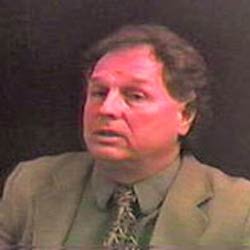
James McCanney
Perhaps one of the most controversial figures in astronomy, offering
evidence that a planet-sized body may come close to Earth as early as this
May, James McCanney, M.S., a former theoretical physicist at Cornell
University, spoke with The EDGE about his findings, which are detailed in
his recently published book, Planet-X: Comets & Earth Changes.
Subtitled “A Scientific Treatise on the Effects of a new large Planet or
Comet arriving in our Solar System and Expect Earth Weather and Earth
Changes,” this book has some people quite nervous and reportedly has high
governmental officials planning ways to protect themselves in the case of
cataclysmic disaster.
What is the nature and origin of Planet X, also known as the
tenth planet in our solar system?
James McCanney: First of all. I want to put in perspective
the solar system in general and I’ll do this throughout the interview to
clarify my beliefs, as opposed to what you may hear or say from a standard
astronomy textbook.
First of all, the solar system was not created all at one time as NASA
would have you believe. All of the planets except for Jupiter have been
adopted into the solar system one at a time throughout the history of the
solar system. The original star system was just Jupiter and our Sun. So
throughout history, we’ve gathered occurrences where new planets come into
form by an electrical process. They become very large comets and then nestle
in as planets, and my theoretical work shows how all of this happens. Let’s
call any new planet to come into the solar system “Planet X,” because that
is a term that is used for objects that have not been named yet.
If we could go way outside of the solar system and look back at our solar
system from a distance and identify all of the bodies that are associated
with it, we would see numerous large objects, possibly in very large orbits
around the Sun.
Only a few of them come into the inner solar system where we live, and the
ones that do frequent the inner solar system, some may be on orbits of 100,000
years, while some might be on orbits of a few thousand years.
These objects are the ones that have affected Earth in the past. We are now
expecting another object, which possibly has been here before, to come into the
inner solar system within possibly the next 10 years — and there is a good
reason to believe that it might be as early as May 2003.
This Planet X is in the category of large solar system objects that orbit our
Sun and also come within the planetary region of our solar system occasionally.
A few of these in the past have come close enough to Earth or close enough to
the Sun to cause serious damage to planet Earth. I also should mention that we
see the marks of these “invaders,” so to speak, or these periodic visitors on
the other planets. For example, Mars is devoid of an atmosphere and its oceans,
but it’s very clear when you look at Mars that it lost its water and atmosphere
recently. So, the belief that an object could come into this solar system and
drastically affect Earth is not that outlandish.
NASA, of course, will try and tell you that the solar system formed all at
one time four and a half billion years ago and all the planets have been in
stable orbits since then, but even NASA is discovering new planets that it never
knew about — and it has no explanation for where these mini planets came from.
I want to mention Hale-Bopp, the comet that visited the inner solar system in
the 1990s. It was a perfect example of a new planet that is in its formative
stages. NASA kept secret the real information on Hale-Bopp long before its 1995
discovery, which was made public, that it was on a near-collision course with
Earth. However, due to its dragging in the tail material and becoming larger,
its orbit was altered so that Earth moved ahead three months during that about
nine-year period to the point where we were no longer on a collision course with
Hale-Bopp. The other thing is NASA has been lying about the size of the nucleus
of Hale-Bopp. The nucleus of Hale-Bopp is about the size of our Moon. They claim
that it’s only a large comet, possibly only 80 miles in extent. So, we’ve
already seen one of these Planet X type objects.
NASA was in communication with the Vatican during the 1990s, and the Vatican,
in fact, built a major observatory in Arizona, staffed it with NASA astronomers.
The main purpose of that observatory was to observe the large comet Hale-Bopp.
The question the Vatican posed to NASA was, “Is Hale-Bopp wormwood?” (Wormwood
is the the large planetary object referenced in Revelations that ravaged Earth.)
So they all knew very early in the early ’90s that this large comet, Hale-Bopp,
was on a near-collision course with Earth, but throughout the ’90s they refused
to make this public. The Hopi Indians believe that Hale-Bopp was the precursor
to what we call Planet X. My personal belief is that Hale-Bopp was a small
companion to the large Planet X on its previous visit about 4,000 years ago and
that there was also another companion to Planet X, which later became the planet
Venus, as explained by Immanuel Belikovsky.
My theoretical work shows how comets are not dirty snowballs, that they are,
in fact, a plasma-electrical phenomenon involving the Sun and an astroidal comet
nucleus and, in fact, that these comets are dragging in the tail material and
becoming larger. So, in the case of Venus, my theoretical work explains how
Venus was a huge comet, ravaged Earth on two separate occasions about 4,000 and
3,600 years ago and then as it absorbed material from the comet tail, eventually
nestled into the orbit where we see it today.
Could you please explain the history of your work back to 1979 when
you were on the faculty of Cornell University, which led to your current book,
Planet X, Comets and Earth Changes?
McCanney: I was a theoretical physicist at that time, studying
celestial mechanics and plasma physics on my own. I also had access to NASA data
from space probes, which were newly discovering the properties of Jupiter,
Saturn, Venus and the other planets.
What I found was that the expectations of traditional theory were not being
met. I found that the electrical, magnetic nature of the solar system that I had
been studying quietly in the back room was very pronounced in the data that was
coming back from these space probes. Thus, I began publishing my papers in
astrophysics journals. And then I was actually relieved of my teaching position
at Cornell because my theories (about the nature of comets) were so radically
different from the standard norm. I lost my teaching position and was
blackballed from further publication.
I continued to study this over the past 30-plus years and this has led to my
current book, Planet X, Comets and Earth Changes, which was written for the
general public. It also contains the early technical papers in the back for more
technically minded people. The book was written to explain my theories on how
the Sun’s electric fields affect our weather and what I call Earth changes.
My point is that these large comets, which are fairly rare but do visit our
inner solar system occasionally as is imminently clear from historical records
from the ancients, can drastically affect the planet in numerous ways. In the
book I explain the theoretical nature of comets and describe how they become
planets, new members of our solar system, and also how their near-approaches to
the inner solar system can cause dramatic Earth changes.
What are some of the Earth changes expected to take place as this
planet approaches the Earth?
McCanney: First of all, we don’t have a definite sighting on
this object. There is a belief, based on NASA’s internal studies from the early
’90s, that this object is coming in from a southerly location that is only
visible during the month of May from the very southern locations on Earth,
specifically New Zealand. Last spring, the weather in New Zealand did not
cooperate and we were unable to get good observations, but we’re waiting
possibly as early as February of this year to be able to observe this object in
the southern hemisphere as the Earth turns around the Sun.
We do believe a large, new object is coming into the solar system because of
the preparations of the governments around the world, including our own. They’re
building cave cities for certain elite members of our society and basically
leaving the rest of us out to hang like dirty laundry in the wind.
The effects on the Earth are very clear, both from my theoretical work and
from what the ancients describe. There are episodes of mountain building. There
could be a pole shift caused by a gravitational tidal wave that moves through
the surface mantle of the Earth. There would be flooding both from tidal waves
of the oceans, tremendous atmospheric storms and also from a huge pollution
influx of oil and water — hydrocarbons and water — from inner planetary space
onto Earth. And all of these things have been seen in the past.
The Bible talks about, for example, when all the vermin, bugs, insects and
snakes came out of the ground and overran the Earth. This was a direct result of
the electric fields penetrating the mantle of the Earth and causing these
creatures to leave the ground and come out of the ground. The atmospheric
conditions include the increase in the number of volcanoes going off.
I want to mention is that these planetary objects do not have to come
necessarily that close to Earth to cause even dramatic Earth changes. Electrical
discharges can occur between the planets even a distance apart. These, in fact,
have been measured with NASA satellites where, in the 1990s, we saw incredible
electrical discharges flow between Jupiter and Earth, taking out a number of our
communication satellites. The scientists at that time were totally puzzled that
outer space could do this. They still don’t understand the very electrical
nature of our solar system. My book explains, in fact, how this works in a
theoretical sense, and it also explains in a practical sense the effects it
would have on planet Earth.
Have we already seen any of the effects that could be attributed to
Planet X?
McCanney: Absolutely. We’re seeing the Sun at an excited level
never before seen. There was a solar maximum in the year 2000 that would be the
expected time for the Sun to reach the maximum of activity on its 11-year solar
cycle, and after that it would be expected to diminish in energy over that
11-year span of time. We should be well on the way in the year 2003 to the solar
minimum, but instead, the Sun is at an explosive state never before seen in the
history of our solar system. My theoretical work shows how, in fact, the Sun is
interacting with some large object that we have not seen yet — NASA probably has
seen it, but it is not telling us — causing the dramatic solar flares that we’re
seeing.
Are there any safe zones to be aware of should this come to pass?
McCanney: It’s very difficult to say that there are so-called
“safe zones.” You might be safe from flooding in one area, but earthquakes and
volcanic activity might be devastating. The best thing you can say is that it
would not be safe to be near the oceans, because of the movement of the oceans,
tidal waves and that type of Earth change.
What is desperately needed is public awareness so we can build safe shelters,
domed regions with reinforced cement. We know these structures will withstand a
lot, but right now there’s been no preparation except for the people who we call
“leaders” in this country. They’ve prepared for a 50-year span where they would
be safe in caves, without informing the public who, very much at this point,
could be on the road towards preparedness and being in a mode of being much
better off than they would be with no information and no preparation.
Please explain how the findings of ancient civilizations in the
so-called Ice Age relates to your theory.
McCanney: What is very clear is that the Ice Age that we see in
North America, what we call the Laurentian ice shield, was actually the old
north polar cap of Earth. At that time, Siberia had a tropical climate and the
south pole was in the region of the south Indian Ocean. What we’re finding is
that the mass extinction that included the mastodons, the woolly mammoths and
the saber tooth tiger was an event that occurred due to the passage of a very
large celestial object that caused the poles to move approximately 30-40
degrees.
The old north pole of Earth used to be somewhere north of the state of
Wisconsin, and this shift happened overnight. The mastodons in Siberia that are
frozen in the tundra, for example, were quick-frozen in a moment’s notice. The
one they dug out of the tundra just a year or two ago, was standing on all fours
with undigested tropical plants in its throat. In other words, it was frozen,
alive, while standing. We find this type of devastation all around the world.
We’re also learning how vast civilizations of humans around the globe were
devastated at that time. Entire cities, predating the Egyptian pyramids, are
being dug out of the lower regions of the Andes mountains in South America. An
ancient pyramid-type city, off the coast of Cuba, was recently discovered 2,000
feet under the ocean surface. And, of course, we have tales of cities like
Atlantis and the prediluvian world, with standard science trying its best to
explain away all of this as being localized events. But what is crystal clear is
that this was one worldwide event caused by the passage of a large celestial
object — and we are expecting that this could happen in the future with the
passage of a large object that we call Planet X.
This passes approximately every 3,600 years?
McCanney: There are people saying numbers, but I don’t give
numbers myself unless I have scientific data. There are people claiming that
they have visions or other sources of information that would indicate May 2003
would be the date of the next passage, but I won’t predict dates or project
dates into the past without definite scientific information. There is a definite
dating structure, however, that shows that approximately 3,600 years ago there
was a major event on this planet caused by an extra-celestial object. But, when
it will happen in the future is unknown scientifically at this time, except to
the people in NASA who are hiding the information from the public.
Most of the information about Planet X, comets and earth changes have
been strictly grassroots. Why hasn’t NASA or the government released this
information to the general public?
McCanney: NASA scientists are under a strict National Security
Agency contract to not talk to the public at all. They cannot talk to the public
about anything. NASA has official news release agencies. NASA has been
confronted with the topic of Planet X, but it has chosen to send out
representatives who are not NASA employees, and the first thing that they say is
they do not represent NASA or their interests. To date, NASA has refused to make
a public statement on record regarding Planet X, its arrival date and what they
know about this large object that we believe is coming in the solar system.
Now, there’s been much disinformation on the subject in the media.
Can you shed some light on this?
McCanney: If you go on the internet and search for Planet X,
you’ll find a tremendous amount of disinformation. There has been a concerted
disinformation campaign by the government through people on the internet, some
of whom claim to be visionary or talk to aliens. Other disinformation comes from
people who simply use their first name. What I’m attempting to do with my book
and radio interviews is draw a middle ground and some clarity to this topic.
I’ve been on possibly 50 national radio shows in the past four months. I have
my own radio show on the internet every Thursday night from 9-10 p.m. Eastern,
streaming on the internet [www.realityradionetwork.com]. You have the
disinformation people on the internet on one side, and you have the government
introducing disinformation on the other, leaving the public unable to understand
what they should believe. That’s why I have been very popular on these radio
shows. People understand what I’m saying and it makes sense.
Now, Jim, is it possible that this is one of the cataclysmic events
prophesied by those such as the Bible, Nostradamus and Edgar Cayce?
McCanney: Yes, and if you look at not just the prediction of
Earth changes and dramatic Earth devastation, many of the other prophecies are
very much coming in line with this event. So, for people who have studied those
topics, most people agree that we are on the verge of having another major Earth
change. The Hopi Indians have an entire legend built around this. Their early
cultures talked very much about the passage, about the seven stages of Earth
changes as they called them. They make no qualms about the Earth changes. They
say that the comets are the things that cause this and that the blue comets are
the dangerous ones. We now know scientifically that the blue comets are the
dangerous ones, because those are the ones that are so electrically active that
they literally light up like a light bulb in the daytime sky.
Is it expected that there will be a collision with the Earth or are
these changes going to happen by a near passage?
McCanney: The probability of a direct collision is very remote
and very small, but in the past we know that these things have occurred without
a large crater on Earth. In fact, all of the Earth changes can be explained by a
near passage of one of these large objects through the inner solar system.
In fact, my book talks about what I call “action at a distance.” That is, the
object does not have to be anywhere near Earth to cause dramatic Earth changes.
For example, the object could interact electrically with the Sun, as it is doing
now, the Sun would throw out an enormous solar flare and that would drastically
affect our weather, causing tremendous storms that would devastate the Earth. It
could reverse our magnetic field, causing a high amount of radiation to come
into the planetary surface. It could increase the number of volcanoes that
become active and cause earthquakes. We already know that the Sun can do this
without the Planet X object being near Earth.
Do you believe that if the public is well-informed about this event
that they may take steps to prepare for it?
McCanney: The entire purpose of my going public, and writing my
book, is to make the statement that it’s not a matter of “if” this is going to
happen. The question is only “when.” Preparation at an early stage is
imperative. It would be a mistake to wait and allow ourselves to expect to
prepare at the last minute.
Government scientists are mistaken when they believe that this passage will
only cause a day or two of trauma to the Earth. We are already seeing the
effects of a large object in the solar system, and a near passage would cause
months of effects before the passage and possibly years of effects afterwards.
So, it is imperative to prepare early and to have good data that NASA is hiding
right now that would help us prepare.
Now, looking at this from a spiritual aspect, could it be that this
is a triggering device to awaken souls to the time of transition and a shift in
consciousness and not an end-time scenario as many view it to be?
McCanney: Absolutely. The human consciousness is definitely
going to be awakened. For people to survive, it will not be possible for them to
crawl into a cave by themselves with supplies and somehow come out of this as
the sole survivor. It will have to be a total community effort where people
understand what the damage and dangers would be and to prepare for it in a
communal type of manner with total cooperation. Without such cooperation, there
won’t be any survivors — if it’s as serious as we think it possibly could be, if
it’s as serious as it has been in the past.
We see that the civilizations that did survive the last encounter actually
formed many of the religious beliefs that came out of ancient culture. For
example, a simple one is that if a man died, his brother would marry his wife to
keep the procreation going, because at that point they were in a desperate
survival mode. So, you find that much of the civilizations that did survive in
the past did so as civilizations, not as individuals.
Along with your book, Planet X, Comets and Earth Changes,
could you recommend any other good sources of information to people who would
like to learn more about this topic?
McCanney: As I mentioned, I host a weekly radio show on the
internet and I also have a website that I keep current with information. Other
books that would be pertinent might be Mark Hazlewood’s book, Blindsided, which
talks about the possibility that this object could be here as early as May 2003.
Mark’s book is important because it made the public aware of Planet X, not so
much as he is specifying a date for a passage.
A tremendous source of information is the work by Immanuel Velikovsky, who
wrote three books describing his translation of ancient texts which, in fact,
describe what the ancients encountered during the last series of Earth changes
caused by an extra-solar system object. I’m going to mention also that NASA has
spent decades downgrading his work, but what my work shows is that Velikovsky
was right on the mark. The only thing missing from his books, which were written
in the 1950s and describe Venus as a large comet that devastated Earth on two
occasions 3,600 years ago, was a sound theoretical structure for his space
science — and that’s what my work provides. It explains how comets become
planets and how they come into the solar system and are formed. What is clear
from recent space probe data is that all of the theories presented by NASA are
incorrect.
In an overall statement to society in general, what is it you would
like to tell them about the whole subject of Planet X and what is the message
that we need to receive from this?
McCanney: The entire message of Planet X is that Earth has
experienced and that civilizations have experienced these events in the past and
they will happen again in the future. As a civilization, we have to prepare for
this as it will be the most Earth-changing event in our future. Left totally
unprepared, it might happen in 100 years, it might happen in 50 years, it could
happen within the next 10 years or it could happen this coming May, but given
any of those scenarios, we, as a civilization, as a species, must prepare for
the most devastating event. If not, as a civilization we are doomed. And, being
prepared is the most important thing that we can do.
We can build cement domes that kids could play in when this is not an
imminent danger, but left totally unprepared there would be nearly a mass
extinction of the human race. That’s why it’s imperative that we prepare now,
whether it’s in the near future or the more distant future. We must prepare
mentally, physically and spiritually as a human race for these events because,
as I said before, it’s not a matter of “if” it will happen, but a matter of
“when.”
Our government, obviously, is doing this major cover-up about Planet
X. What are the other countries doing? Are they covering up the information as
well?
McCanney: What’s interesting is that this is public knowledge
in other countries, including Russia, where we usually would consider it to be a
state where the government controls information. The topic of Planet X has been
on billboards in Moscow, so the public around the world is very much aware of
this.
The news media in the United States is very controlled by large corporations
and government influence. In fact, the United States is one of the regions where
very little, if anything, is known about Planet X amongst the general public.
Throughout the ’90s, top space scientists and astronomers in Russia took my
published scientific papers, translated them into Russian and were teaching them
to graduate-level science students in Russia in the top universities. Later in
the 1990s, I noticed my e-mails were being intercepted, and eventually, my
contact with the Russian scientists was cut off entirely.
The Russian scientists became very interested in my work because they were
experimentalists, atmospheric experimentalists and space scientists and they
were measuring effects that they didn’t understand. When they read my papers
they realized that my papers explained what they were seeing.
For more information, go to James McCanney’s homepage at
www.jmccanneyscience.com
Copyright © 2003 Cathy Jacobsen. All Rights Reserved.
|
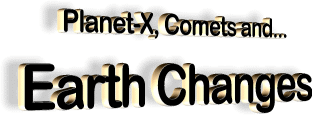
by J.M. McCanney
edited by Harrison Koehli
from Sott.net
21 March 2011
from
Sott Website
Spanish version
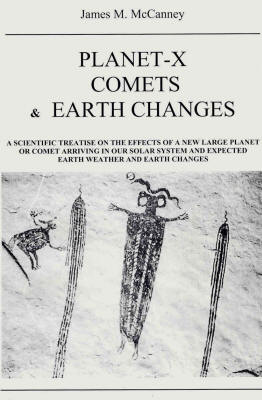
Planet-X,
Comets & Earth Changes
by James M. McCanney
Minneapolis, MN: jmccanneyscience.com press, 2007
(first published in 2002)
182 pp.
A new model of
the Universe
A scientific revolution in the theories of the nature of comets,
solar system formation and astronomical phenomena in general is long
overdue.
For example, the
impossibilities and contradictions inherent in the "dirty snowball
comet model" and the "nebular collapse" theory of the origin of the
solar system are legion. The theories fall short of explaining
observed phenomena, but you'll never hear the scientists promoting
them admit as much.
Unfortunately, it seems
that in all their mental excavations, the mass-produced scientists
of our time have dug themselves into a trench of dreary proportions,
carried along by the inertial stream of their cherished professors'
naïve opinions. In fact, they can't even tell how deep they are in
it, or that their theories are as woefully outdated as the mastodon
fossils of which they catch passing glimpses.
And thanks to James
McCanney's work over the last thirty-odd years, they find themselves
plunged, in the words of Mullah Nasr Eddin,
"into the deepest
galoshes that have ever been worn on sweaty feet."
James McCanney is something of
a maverick in the scientific community.
Having taught physics
and mathematics at Cornell University, he was ousted because of
pressure put on University authorities by professors in the
astronomy department who didn't like what he was publishing. In that
sense, academia is a tad like life in the Mob: "You can't say these
things. If you do, we'll ruin you."
But while McCanney may
have suffered the fate of any scientist who attempts to go against
the grain, his theories continue to hold up, predicting newly
observed phenomena without having to resort to the "creeping crud"
of widely accepted, bogus theories (McCanney's term for the
shameless "revision" of old theories to account for unexpected
observations).
McCanney's first book in a series presenting his ideas, Planet-X,
Comets & Earth Changes: A Scientific Treatise on the Effects of a
New Large Planet or Comet Arriving in Our Solar System and Expected
Earth Weather and Earth Changes, introduces his theoretical work on
these topics. It's divided into thirteen short chapters describing
the scientific concepts in layman's terms, followed by reprints of
his original scientific papers published in the early 1980s.
The net result is
three-fold:
first he takes apart
the current theories, evangelized for decades by inept
institutions such as NASA and the NOAA. Then he presents his own
theories, accounting for all those pesky "anomalies" ignored or
explained away by mainstream scientists.
Besides accounting for
these anomalies, as he explains in Part II of his "3-Part Comet
Paper", included in Appendix II:
Any alternate theory
concerning comet behavior and the origin of the solar system
(OSS) must re-explain many observed phenomena in a
self-consistent context.
These include the
origin of comet nuclei and the reason for the observed
"families" of comets arriving from many specific directions in
space, comet wandering, sunward spikes, sunward fan tails,
occasional separation of the tail from the nucleus, comet
splitting, the cause of Type I, II, and III tails, the spiraling
of tail material, the stratification in some tails, multiple
tails, the shrinking of the coma as the comet approaches the
Sun, and the maintenance of meteoroid streams.
In relating the above to the formation of planets, moons and
asteroids, the theory must also explain the internal heat and
radioactivity of the planets, the orientation of the rotational
axes of the planets, the spacing of planetary and lunar orbits,
the asteroid belt, the source of planetary atmospheres, the size
distribution of celestial bodies, the cause of retrograde orbits
of selected moons, and last, but not least, the magnetic fields
of the planets.
This must all be
done in a context consistent with data (although not necessarily
with uniformitarian theory) in other fields such as geology,
biology, archaeology, anthropology, etc."
("3-Part
Comet Paper" Part II, p. 61)
Following that, he
describes what it all means for us living on planet Earth, what has
happened in the past and will happen again - effects of which most
scientists are either unaware or unable to speak due to signed
non-disclosure agreements.
But first, what exactly
can't the current theories explain? Surely, there can't be any holes
in the "wisdom" parroted about as if it were holy dogma these days,
right?
To avoid any excess
sarcasm (there's enough of that already, and more to come!), I'll
let you guess my answer to that one. I'll just say that these
"anomalies" have all either been ignored or the current theories
simply modified with "correcting factors" to account for the
unexpected data (thus creating even more inconsistencies).
The nebular theory of OSS, for example, has mighty difficulty
(without fudging numbers or creating new physical phenomena)
explaining the formation of large proto-planets let alone small
comet nuclei in terms of gravitational collapse of gas clouds,
Saturn's large energy output, Venus' greater energy output than
input from the Sun, the moon Titan's high temperature compared to
the little sunlight it receives, the maintenance of Pluto's
atmosphere, electrical current flow between Jupiter and its moon Io,
and various other electrical phenomena observed in space, to name
just a handful.
The "dirty snowball
comet model" (DSCM), in turn, can't quite wrap itself around the
continual renewal of comet coma, their curvature and well defined
edges, "sunward spikes" with intense radio signals coming off the
nucleus, tail spiraling, etc.
As McCanney points out
above, any good theory must account for all of those, and more. So
what does he offer instead? The "comet capture theory of OSS" and
the "plasma discharge comet model" (PDCM), according to which our
solar system, and space in general, is not electrically neutral.
Rather, we live in an
electric universe.
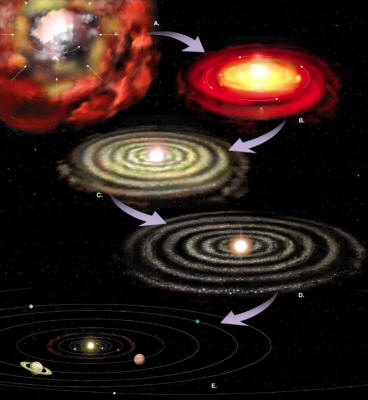
An illustration of the current "nebular collapse" theory
of
solar system formation taught to all students of space science.
Let's start big, like galaxy big.
According to the
received wisdom, our solar system formed more or less at one time,
four-point-something billion years ago (give or take a day or two).
You can read about it on Wikipedia. Basically, in the beginning was
the Great Nebular Cloud, which was pretty bored and lonely being a
just cloud and so collapsed and flattened into a Really Big Disc,
out of which several varied planets and moons gradually coalesced.
If it sounds like a
myth, it's because it most likely is. According to McCanney's theory
(described in the paper in Appendix I), the picture is pretty
different, being both logical and accounting for those
aforementioned "anomalies", including the "missing mass" problem,
the spiral shape and symmetry of galactic arms, and the surplus of
twin star systems observed in our galaxy.
In this model, stars and
planets, as well as smaller comet nuclei, are all formed at the same
time from cosmic dust continually emanating from and returning back
into the galactic center. Basically, the cosmic dust collapses
inward toward the nucleus, and condensed material is ejected outward
in a "shotgun effect". (Because all these objects are formed in the
same way, this means that stars may actually have solid cores, the
source of heavy isotopes ejected in supernovae.)
Ejected bodies will naturally stabilize into dual orbiting systems,
explaining the observation that over 80% of star systems are
actually twin-star systems, the remainder probably also being
twinned, although with more introverted companions of the unlit
variety (e.g., brown dwarfs or gas giants).
(Incidentally, McCanney
believes Jupiter is the Sun's unlit twin, as they alone share the
same spin axis among solar system bodies, but we here at SOTT favor
the
brown dwarf theory, for which
Walter Cruttenden gives some evidence in his book
Lost Star of Myth and Time.)
As these two bodies
stabilize in their orbit of one another, they eject smaller bodies
to go out into the world and find their own solar system.
So where do comets come from? Aside from being rudely deflected from
the sphere of our stellar young lovers, another source of comets is
the material ejected from stellar novae, the small bits flying away
at great speeds with the biggest bits staying behind. (This may
explain the "families" of comets that appear to come from the same
source in space.)
These ejected bodies
from the galactic center and supernovae will later be captured into
the orbit of one or another of the bodies of an already-paired star
system, in the manner in which comets are "captured" into solar
systems by large planets like Jupiter, falling into stable orbits
over time and accreting mass in the methods described below.
So while stellar pairs
may enforce their privacy at first, they can't forestall the
inevitability of certain "cosmic accidents".
But before we continue our story of cosmic "Married with Children",
we need a few more concepts with which to work, namely, from the
plasma discharge model.
McCanney writes:
It has always been
assumed that the solar wind contains equal currents of electrons
and protons to maintain an electrically neutral solar system.
But there is no reason for assuming this is so. It would be
impossible to detect the overall current leaving the Sun at any
given moment.
The few points at
which the solar wind has been monitored can in no way be
extrapolated to say that there are equal currents of protons and
electrons in the solar wind as has been done by theorists.
External characteristics, e.g., comet phenomena and electrical
phenomena in Saturn's rings, indicate that there must be an
excess current of protons.
In solar prominences
are seen composite streamers of similarly charged particles
moving in the local magnetic field, so there can be no doubt
that the Sun has the ability to selectively eject composite
streamers of similarly charged particles.
("3-Part Comet
Paper" Part I, p. 25)
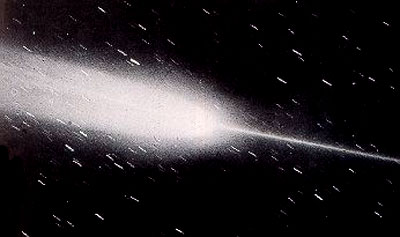
Comet Arend-Roland's sunward spike - a high energy electron beam
connecting the discharging comet and the Sun.
Basically, electrons' movement is slightly retarded in the Sun's
corona, with solar flares hurling out an excess number of protons.
The excess protons in
the solar wind creates a separation of charge throughout the entire
solar system - a giant capacitor with a positively charged,
doughnut-shaped nebular cloud of dust and gases stretching to the
far reaches of the solar system, and the negatively charged the
surface of the Sun.
An electrical potential
exists between these two poles and any object moving through plasma
regions of varying charge density will become charged, depending on
its size and relative velocity. When new bodies (e.g., comets) enter
this plasma region from outer space, they ignite and begin to
discharge the solar capacitor.
The comet nucleus
acquires a negative charge, with electrons flowing towards it in the
form of a sunward spike. The excess protons and other positively
charged ions (including light elements up to sulfur) making up the
nebular cloud and zodiacal disc (which contains the heavy elements)
flow into and form the comet tail. So the comet tail has nothing to
do with water vapor streaming from a melting "snowball", although
that's not to say that water can't be a component of a comet tail -
quite the contrary.
The Sun is an interesting thing (seriously!).
Compare it with a gas
giant like Saturn. Both are surrounded by a plane of stratified,
ring-like structures: the familiar rings of Saturn and the Sun's
zodiacal disc (the dusty material spanning the plane of the
ecliptic) with rings at certain distances, e.g., between Mars and
Jupiter. In fact, both Saturn and Jupiter exhibit certain star-like
properties and electrical phenomena, leading McCanney to some
interesting hypotheses.
Besides rings and
satellites, they display
interplanetary electrical discharges
(e.g., between Jupiter and Io), energetic particles, differential
rotation (the equator of the Sun rotates faster than the poles),
high temperatures, exothermic radiation, and highly energetic
atmospheric lightning.
According to McCanney,
this lightning is actually what triggers fusion reactions (the
burning of hydrogen and helium) on the Sun's surface, i.e., not in
its core. Like the gas giants, the Sun should have a solid core,
where radioactive decay takes place.
This brings us back to family matters and unplanned parenthood. If
planets can become stars, can comets become moons or planets, and if
so, how? Let's follow a comet as it journeys into the solar system
and see what happens based on McCanney's comet capture theory. As a
small comet enters the solar system, it will be seen to light up,
discharging a relatively small and localized region of the
capacitor.
Several types of tail
may be observed, in addition to the brightly lit coma. These tail
shapes vary according to different charge-ratio values (in relation
to the Sun) and the stratification of dust and gases in the tail
itself. Sudden neutralization of the nucleus can cause what is
observed as tail separation, and curved tails form depending on
whether the comet is moving "downstream" or "upstream" through the
zodiacal disc (i.e., relative angular velocity).
Some comets have been
observed to "wander", that is, change their orbital descent (e.g.,
Hale-Bopp's period changed from 4200 to 2650 years in just one
passage).
In McCanney's model,
this is explained by the vast amount of material drawn into the
comet tail. Comets are attracting these materials, not discharging
them through "melting" of nonexistent ice and gas jets. This dusty
material produces a gravitational drag, and has the effect of
circularizing eccentric orbits, making them more uniform.
As a comet's orbit
becomes circular (due to tail drag), it stops moving through the
differently charged areas around the Sun, remaining in one region of
electrical equipotential, thus losing its visibly charged tail. In
essence, it evolves into an asteroid or potential moon in a stable
orbit, its fiery early years over.
However, while comets are usually relatively small in size, some are
potentially huge, discharging the entire solar capacitor, which can
drain much of its energy and cause violent solar storms.
So, how do planets form?
McCanney follows
Velikovsky
in thinking that Venus is a relatively recent addition to
our solar system, entering our solar system as a planet-sized comet
that accreted a lot of mass in the process, becoming the young, hot
planet we see today. (It will eventually become a water planet, like
Earth.) The high temperatures, brought on by electrical heating
during its passage through the solar capacitor, can cause the nuclei
of large comets to become molten, self-gravitating into the
spherical shape common to planets and most moons.
Comets as planets-to-be
also may explain the varied axes of rotation of the known planets,
as well as the initial formation of their atmospheres.
As light elements up to
sulfur have been observed in comet tails, they're the likely
pre-existent source of atmosphere in cometary planets captured by
star systems. While small comets don't have enough mass to attract
and hold the chemical volatiles from space, large comets do,
gravitationally attracting the materials into an atmosphere.
So yeah, it seems that comets are actually the seeds of planets.
Most get cast onto barren earth, but some may grow to bear fruit.
However, as we'll see below, this "childhood stage" of planetary
evolution is anything but easy-going. In fact, when a full discharge
of the solar capacitor occurs, it's more like the Cosmic Terrible
Twos.
To sum up so far, here's the list of theoretical results included in
Part III of McCanney's "Comet Paper":
-
The formation of
a "stellar capacitor" around stellar objects undergoing
nuclear fusion in their atmospheres (the negatively charged
stellar object is surrounded by rings and a doughnut-shaped
nebular cloud of ionized dust, molecules, and ions, forming
an electrical capacitor which may discharge under certain
conditions).
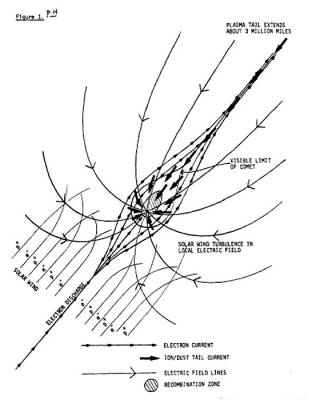
McCanney's comet model
-
Comets are
asteroidal bodies (not ice balls) which discharge this
stellar capacitor, developing a net negative electrical
charge. The comet nucleus attracts quantities of dust and
ions, forming the visible comet tail. ...
-
Comet nuclei are
captured by the solar system at random time intervals and
evolve into the planets, moons and asteroids. Comets are
accumulating matter and are not melting away as suggested by
the ice ball comet model (IBCM). Only rarely do comet nuclei
reach planetary dimensions. The members of the solar system
have varying ages.
-
Gravitational
encounters with members of the solar system and the "tail
drag" are the primary effects which move newly captured
comets into stable non-overlapping orbits. The solar system
is a dynamic ever-evolving system.
-
The gas giants
(Jupiter, Saturn and possibly Uranus and Neptune) maintain
fusion in their atmospheres. The fusion is ignited by
energetic lightning bolts in their turbulent atmospheres,
implying that the Sun does the same. Observations of Jupiter
and Saturn by
Voyagers I and II show the
same electrical phenomena as observed around the Sun.
Jupiter and the Sun were the original twin stars of our
solar system, other bodies being captured one by one at
later dates.
-
Gravity is not
the sole force governing the cosmos. Electrical effects
generally produce only subtle effects, but occasionally they
may dominate the workings of the solar system.
-
Major
Earth-altering events (caused by gravitational and
electrical effects) may occur when large comets pass nearby.
("3-Part
Comet Paper" Part III, pp. 42 - 43)
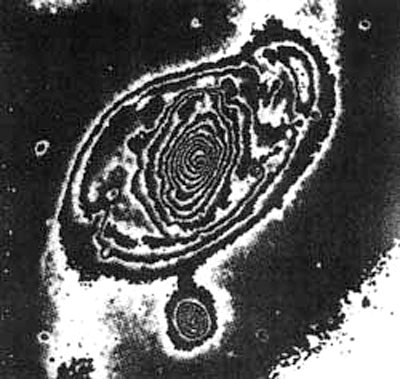
A quasar connected to a galaxy.
Following current theories, the galaxy is traveling 1800km/sec,
and
the quasar 21,000km/sec.
In
other words, the galaxy is 107 million light years away
while the quasar is 1.2 billion light years away, an absurdity.
To these can be added
the two topics discussed in the third paper itself.
Firstly, red-shift
observations have been used to show that comet tails move away from
the nucleus; however, this is actually based on an assumption about
red-shift. There are other causes of red-shift besides Doppler
effects, for example, as a measure of charge (McCanney's calls it
"induced electric dipole red-shift").
This not only accounts
for red-shift but also bending of light and supports other
observations questioning the validity of using red-shift (as in the
Hubble constant) to estimate the distances of stars and the age of
universe. (In other words, it throws such theories as the Big Bang
and the expanding universe into question, as well as General
Relativity.)
Secondly, electrical current flow is necessary to explain magnetic
fields.
Stellar and planetary
magnetic dynamos are not "self-generating", but externally powered
by interaction with other charged bodies and their own inner cores
and atmospheres.
Only
planets with moons have a magnetic
field worth speaking of.
While all planets and
moons discharge the solar capacitor to one degree or another, moons
charge in the manner of a comet (by moving through varying regions
of solar wind) and the current flow between them and their planets
helps create and maintain the planet's magnetic field. The magnetic
field is connected to the jet-stream and plays an important role in
Earth's weather patterns too.
Incidentally, a magnetic
field (which buffers the planet from high energy particles from the
Sun) is necessary for life.
Worlds in
Collision, Earth in Upheaval
Anyways, that's the science so far.
But what does it mean
for us? For those of us like Sherlock Holmes in the contemporary BBC
production Sherlock, what does it matter to us if the Earth revolves
around the Sun or vice versa? Or, in this case, what's the
difference if comets are dirty snowballs or "hot, radioactive
nuclear conglomerates" discharging the solar capacitor?
Well, as McCanney
writes:
Today we are finding
the remnants of ... ancient societies. There were huge cities in
what we now call South America long before the so-called Ice Age
or the alleged crossing of the Bering Strait by early hunting
tribes. What we are learning is that the history that is being
taught as "standard knowledge" is totally wrong.
There is a
tremendous effort in numerous sectors of modern society to keep
the truth of our real past from being told. The seats of
knowledge in our universities, certain religious centers and the
governments of western society are doing their very best to
prevent this information from reaching the general public.
They fear that this
knowledge will set people free from the domination they are
currently under.
(p. ix)
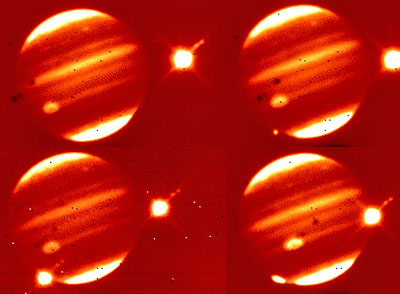
Comet
Shoemaker-Levy
impacts Jupiter,
causing massive explosions.
These ancient societies (just barely) lived through worldwide
cataclysms of immense destruction.
They understood their
severity and passed on this understanding in the form of legend,
myth, and symbol - a warning for the future, us. We have yet to
re-experience such an event in recent history, but we are beginning
to catch glimpses of just what may occur.
When
comet Shoemaker-Levy
was heading towards Jupiter
in 1994, scientists were still harping on the "ice ball comet" meme,
expecting relatively benign "splat" as this harmless ice ball
pummeled into the gas giant. Instead, it broke up into several mini
"ice ball" fragments and unleashed more explosive power than all the
world's nuclear arsenal combined.
But it turns out that a
rare direct collision of relatively small comet fragments is the
least of our worries (as if that weren't enough).
As long as a comet is discharging the solar capacitor, it doesn't
need to collide with Earth for us to experience its effects. Large
solar flares triggered by electrical interactions with comets,
electrical currents flowing to Earth, and gravitational tidal waves
can all take their toll.
This
"action-at-a-distance" phenomenon can cause extreme weather and
storms, volcanoes, earthquakes, floods, pollution events (e.g.,
pandemics, plagues, "Black Death", raining fire, etc.), pole shifts,
mass extinctions, meteor showers, mountain building, and huge
electric discharges between Earth and a large, passing comet.
While certain planetary alignments have the potential to cause solar
storms on their own, a period of very high solar activity is most
likely an indication of a large comet (or comets) discharging the
solar capacitor.
When a large comet
nucleus cuts through the solar capacitor's structure, igniting and
discharging, it sets up a feedback loop with the Sun, pumping up the
Sun's output, which in turn pumps up the discharging comet. When a
third body enters into this alignment, the effects are even more
exacerbated; for example, when Comet Lee aligned with Earth and
Venus causing four major hurricanes to develop simultaneously in
September, 1999.
McCanney lists several
other examples of this sort in his book.
This is why events such
as planetary eclipses, oppositions and conjunctions are of interest
in McCanney's model. These planetary alignments appear to provide
conductive pathways for the solar capacitor to discharge itself.
When a planet suddenly finds itself in the middle of such an
alignment, it essentially gets "zapped", or caught between a plasma
structure of flowing electric current.
It is interesting to
note that astrologers and not astronomers are often the ones more
interested in planetary alignments, positions and so forth. Could
astrology be the remnant of an ancient science practiced long ago
when knowledge of the solar capacitor (and perhaps much more) was
widely understood? Also, what other features of planetary position
and movement (e.g., transit points, retrograde motion, perigees,
etc.) could be of interest in this electric model?
Whatever the answer,
McCanney's book focuses on the alignments with comets and planets
and their apparent influence on Earth in the form of cyclone and
hurricane storms.
On the subject of hurricanes, McCanney writes:
... the reason
hurricanes lost power when they approached land was that the
powering electrical current from the ionosphere to the cloud
tops and to the Earth's surface had no connection (anode) while
over the ocean... so it drew up vast surface areas of ionized
air from the ocean surface and sucked them up a central column
(the spinning vortex was caused by the moist air rising "up the
drain")... whereas the land provided a "ground" for the current
and therefore it shunted out the storm's power source... the
Great Red Spot on Jupiter (and the many smaller storms as well
as the "sun spots" on the sun) are nothing more than ongoing
hurricanes, but since there are not land masses to "stop them",
they keep going on forever, and continue to circle in these
giants in their huge stormy atmospheres.
The giant gas
"planets" and the Sun [have] many counter-rotating rings of
electrical currents that are just like the three "jet streams"
that circle Earth.
(pp. 71 - 72)
The cavity between
Earth's ionosphere and the ground acts as a capacitor itself,
adjusting to maintain a neutral field inside.
So when it is bombarded
with intense solar flares and wind, this cavity compresses and seeks
to discharge itself through various processes such as lightning
storms and hurricanes, but possibly even earthquakes and volcanoes
as well. This excess charge does not discharge all at once, but
passes down through various material layers about and within the
Earth, starting with the ionosphere and ultimately reaching the
Earth's core.
To understand how this
works, we need to know more about Earth's magnetic field, which acts
as a natural buffer between organic life and high-energy particles
from the Sun.
McCanney identifies five layers of magnetic field, two permanent and
three variable.
Earth's central core
(the original comet "seed") maintains a permanent magnetic field,
formed as it cooled early in Earth's life. Next is the molten layer
in the sub-mantle: the area that geologists today believe is the
main driver of Earth's magnetic field. In McCanney's model this
layer is only a lesser component, and subject to influence from the
layers above.
To top off this layer,
there are localized pockets of iron and nickel in the mantle and
outer crust, forming more or less permanent magnetic fields, which
(on average) align with the field of the core. Some of these
magnetized pockets form such large localized distortions of the
Earth's magnetic that compass readings are near useless in these
locations.
(It should be noted that
such regions have also been known for their high frequency of UFO
sightings and other anomalous happenings based on the research of
John Keel and others.)
The variable layers,
starting in the atmosphere going up into space, form the bulk of
Earth's magnetic field, even though they are not permanent in
structure. These layers include the three current flows in Earth's
ionosphere: the three "jet streams" which flow westerly at the
equator and easterly at temperate latitudes. Above that are the Van
Allen radiation belts, followed by the outer current of solar wind.
The alleged "magnetic
tail" flowing from the night side of the Earth is actually a comet
tail, with electrons flowing out and positive ions in.
Solar flares activated
by comet discharges alter these variable layers of magnetic field by
loading them with excess charge, which can in turn lead to
hurricanes, ocean heating (El Niño) and potentially Earth Changes.
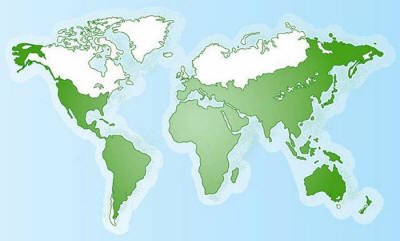
Was North America covered in ice
during the last Ice Age because it was then located in the North
Pole?
It's a rare time that doesn't see hysterical warnings of imminent
"Pole Shifts" among pseudo-catastrophists and doomsayers.
There's a lot of
disinformation being spread about the topic. There are actually two
types of pole shifts: physical and magnetic. Both depend on external
conditions - they don't "just happen".
According to McCanney,
magnetic reversals in the variable fields may occur because of
electrical interactions, but they are only temporary.
The core keeps its true
north, to which the total field re-aligns after the period of
disturbance is over. Findings of rocks and metals magnetized in the
opposite direction are most likely the result of their cooling (and
thus developing their permanent magnetic properties), or actual
physical rotation, during the time in which the variable fields were
off kilter.
Similarly, the passage
of a large comet can have gravitational effects (like the Moon has
on the tides), causing massive tidal waves to course through the
Earth's mantle and oceans, causing chain reactions of earthquakes
and volcanoes. Like the eggshell of a spinning egg, this can cause
the more solid outer layers of the Earth to shift over the molten
layers below.
(In
Atlantis to Tesla - The Kolbrin Connection,
McCanney relates that "true north" used to be inhabited by the
region just north of New York and Michigan before such a shift
occurred several thousand years ago, i.e. a physical movement of
30-40 degrees.)
After the outer layers
settle down, they will resume rotating in the direction of the core,
which, just as it retains its magnetic field, retains its own
direction of rotation. However, such gravitational effects can cause
a slight precession of the core's rotation, offsetting true north
(i.e., Polaris will no longer be the North Star.)
McCanney also hypothesizes a "recombination zone" around the comet
nucleus where the electrons neutralize incoming positive ions from
the tail, making the region a "chemical factory" where elements are
blended into molecules like water and hydrocarbons.
The tarry-black color of
comet nuclei is most likely the result of the intense electron beam
from the Sun burning hydrocarbons onto their surfaces. The fact that
comet tails are attracting materials and not dispersing them is made
all the more clear by the fact that while Shoemaker-Levy's fragments
were seen to be trailing water prior to entering Jupiter's
atmosphere, when they finally did so, the water tails quickly
transformed into sulfur dioxide, i.e., they began attracting the new
surrounding elements.
Incidentally, this fact
may have some important implications for evolution.
Comets contain all the
necessary ingredients for evolutionary processes to work with (not
necessary already-formed life-bearing molecules):
A newly-formed
planet may burn hydrogen for some time before it cools. The new
planet passes through a super hot radioactive phase, followed by
a chemical stage (Venus is presently in transition between these
stages) allowing the free combination of elements, after which
comes the cascade of biological evolution at temperatures below
200F and evidently from a perfectly sterile medium.
Thus, all planets
begin with approximately the same chemicals in the same
proportions and one should expect biological systems to reflect
this.
(p. 73, Part II)
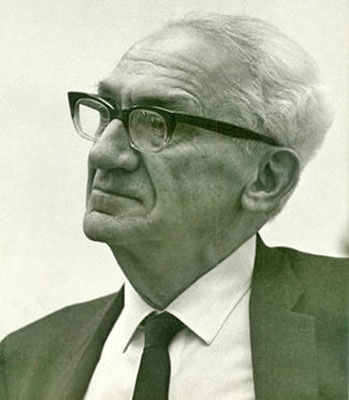
Immanuel Velikovsky, demonized in
his time,
was
more right than wrong, according to James McCanney.
In a giant comet, the materials formed in the tail and recombination
zone provide the source for massive pollution events afflicting
Earth.
The body with the
greater "surface gravity" will pull in the volatile elements from
the atmosphere of the smaller body. McCanney follows Velikovsky in
concluding that just such an event occurred when a cometary Venus
stripped Mars of its oceans and atmosphere (explaining their almost
identical chemical compositions) and then dumped Earth with massive
amounts of water and burning hydrocarbons.
This explains why Mars
has so many features of a water-bearing planet that are still
visible and have not eroded away significantly. In other words, this
passage of Venus may have been a relatively recent event in cosmic
terms.
Besides attracting dust
and gases, the short-range "induced dipole effect" of comets can be
stronger than gravity, especially with smaller objects, thus
explaining how comets can attract meteoroid streams following and
maintaining their orbit. The ancients would have observed and
experienced (as they passed on through myth and legend) mass
flooding and "fire and brimstone" (meteoroids and hydrocarbons)
ignited by the snake-like extension connecting the comet to Earth.
This is the real source
of the world's oil reserves. They rained on the Earth during close
encounters, killing and burying whatever lay beneath. And to top it
all off, the lack of sunlight during such events would lead to a net
cooling of the Earth, triggering a mini-Ice Age.
To sum up, here's a list of possible effects that can occur months
and years before the actual close passage of a Planet-X-type object,
summarized from McCanney's supplement pamphlet Surviving Planet X
Passage (2003, pp. 20 - 25):
-
Violent storms
with excessive lightning, wind and water (drawn in from
space in the manner comets do)
-
Degradation of
complete elimination of infrastructures and facilities
-
Groups of
cyclones, destroying housing
-
Torrential rains
and mudslides, causing mass flooding
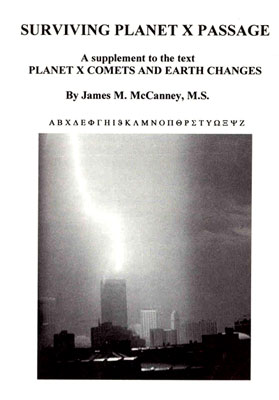
Surviving Planet
X
-
Surviving Planet
X Passage by J.M. McCanney
-
Strong winds and
land hurricanes, tearing up Earth and vegetation (which will
later form coal)
-
Erratic weather,
like snow in the tropics
-
Influx of
chemicals such as water, ammonia, and hydrocarbons
-
Contaminated
water supplies
-
Visible electric
discharges between planets and moons
-
Colorful
auroras, trumpet- and whistle-like sounds caused by
discharging
-
Frequent
magnetic reversals allowing radioactive particles to enter
our atmosphere, causing gene mutations and new species
-
Blotting out of
the Sun leading to mini-Ice Age
-
Meteor stream
impacts
-
"Plagues" as
electric currents force insects and vermin out of the ground
-
"Pillar of fire"
as Earth forms an electrical connection with Planet X,
scorching the Earth and producing deafening noise
-
If the object is
larger than Earth, the loss of atmosphere and oceans; if
smaller, massive pollution events
-
Physical
pole-shift, displacing continents and causing the
flash-freezing of animals (e.g., the Wooly Mammoths) and
causing earthquakes and the eruption of old and new
volcanoes
-
The above
resulting in an altered orbit, rotation, and tilt of the
Earth, requiring a re-calibrating of our calendar (for which
McCanney gives practical instruction in the pamphlet)
That's the picture
painted by early humanity.
Whether it's some or
all, that's what is coming.
Idiocracy
McCanney's theories turn contemporary science on end, throwing
almost all of our currently accepted theories into question,
including,
We do not have to
fight a war in the mid-east for oil, as it is found the world
over and in abundance. It is not the result of millions of eons
of decaying plant life.
If it were, where
were the fern forests that grew under the oceans?! I have yet to
see any chemist show how dirt decays and transforms into crude
oil and natural gas. There are literally oceans of oil all over
the Earth.
It ARRIVED ON Earth
as part of multiple large-scale pollution events from passing
large comets. It is not a rare or limited commodity, and it is
not the rare substance controlled by just a few elite people.
There are better ways of powering our need for energy (e.g.
tapping into the solar electric field as Tesla was doing for
free).
The real reason we
should cease using oil is because it pollutes the environment.
(p. 64)
If practically
everything we "know" is wrong, it becomes clear that the
scientific/university system is not set up for free-thinkers.
The reality of the
Ph.D. educational system today is that if you truly were a free
thinker, you could never possibly get a Ph.D. in astronomy or
space science ... since you would know about this history [of
science] ... and when you brought it up and pushed for the
truth, you would have been led to the door and another eager,
unsuspecting young mental athlete would have taken your place.
Getting a Ph.D. is
based on one's ability to pass tests and regurgitate what you
have been told.
Questioning it is
not part of the process. And once you get that Ph.D. and get
your first post-doc position and then your first tenure track
position, you are well trained in the art of not questioning the
axioms of astronomy.
(p. 41)
Indeed, in his books and
on
his shortwave radio show, McCanney
refers to the mass of "tier-two science", i.e., the disinformation
science that is necessary to prevent people from knowing the truth.
Because, the truth will
set you free, literally - free from the slavery of economic and
political control.
Just as psychopathic
politicians need bogus psychiatry and psychology to prevent an
accurate diagnosis of the problems of pathocracy, the same dynamic
plays itself out in physics, astronomy, history, and just about any
other field of science you can think of. Who can make money if
energy is free? Who can maintain their positions of affluence when
people are able to live self-sustaining lives?
The entire edifice of
political control in our times needs people to be ignorant. And NASA
plays a big part in making that so.
McCanney relates that
when he covered the Hale-Bopp controversy on his website in the
1990s,
Much of the internet
traffic which was trapped by originating addresses of the
visitors ... saw a large volume of the traffic coming from
astronomy and astrophysics departments of universities as well
as continual traffic from NASA, the Department of Defense, Staff
of the National Labs, the NSA, CIA, and other letter agencies of
government.
If comets were just
silly little insignificant snowballs then it sure is unusual to
see all the interest in someone saying they were not.
(p. 44)
The NASA news release system is strict and comes only from
designated NASA news distribution points in Goddard and JPL.
Individual scientists are under strict non-disclosure agreements
not to disclose anything individually.
All news outlets
must go through designated channels. These scientists are
equally restricted under the NSA decree that they cannot discuss
or admit publicly to any event or situation that might cause
public alarm.
That is why the data
regarding a new arrival like Planet X will not be allowed from
the halls of NASA. They are under strict contract not to tell
the public.
(p. 49)
Behind the tier-two
science are the scientists who have a clue, only they're doing their
work under strict, private (as in "black budget" private) and
government contracts.
These scientists are
aware of what's really going on in our solar system, and they've got
the tools to see the signs. (According to McCanney, NASA knows of
one such
Planet X-type object approaching
from south of the solar system, from data produced in the 1990s. It
is only viewable in May from
observatories very low in the southern
hemisphere.)
They are exploited by
the pathocrats who run the show, and we never see their work. They
are the ones "in charge" and they intend to keep it that way. If the
public were to know the truth about what is coming to humanity, do
you really think these men and women would be able to keep hold of
their positions and come out on the other side unscathed?
Neither do they, so they
plan on saving themselves and leaving the rest of us to the fate of
dinosaurs.
As this book goes to
print, all the major observatories of the world are being taken
off line. Astronomers are being told not to discuss "Planet X"
with the public. As with [Hale-Bopp], NASA has shut the door on
release of information.
They are positioning
their scientists to become part of the nightly national weather
programs, and to be in position to defray any public awareness
of what is truly happening with the Sun and our planetary
system.
(p. 84)
The truth is that NASA, the
NSA, and other government
agencies are prohibited by law from disclosing to the public
anything that would cause a national panic. So too they will try
to prevent dissemination of my theories about comets because it
might cause a public to redirect its allegiance as a new and
potentially dangerous comet comes into the solar system.
While the government
officials are using tax dollars to build safety caves for their
"shadow government" in case of "major disaster", they are
leaving the public out to dry with no forewarning or protection.
(p. 83)
But as McCanney points
out in
Surviving Planet X Passage, even
this will most likely fail (and if it doesn't, they'll have all
those "left behind" to deal with when they eventually crawl out of
their holes):
The governments of
the world have built extensive cave cities using nuclear powered
tunneling machines that leave a glass liner as the heat of the
nuclear reactor motor melts the shell of the cave as the
tunneling machine passes through.
These are likewise
provisioned with 50 years of food, medical supplies and every
sort of amenity that we live with today. Some are under minor
mountain ranges while others are burrowed into the sides of
massive granite mountains.
These caves will
actually be the worst place to be since the gravitational waves
will turn these man-made caverns into fractured underground
death chambers.
(p. 40)
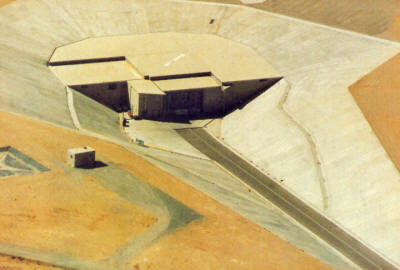
What is the real purpose of
underground bases?
With
psychopaths in power, it's the
natural scenario to expect to be played out: using tax-dollars to
create vast, secret underground bases and leaving the rest of
humanity to its fate.
As astrophysicist
Victor Clube
wrote, this official control of information has happened
before (see also Clube's and Napier's description of how leaders
have promoted a non-catastrophic worldview throughout history in
order to cement control, in their book
The Cosmic Winter):
Confronted on many
occasions in the past by the prospect of world-end, national
elites have often found themselves having to suppress public
panic - only to discover, too late, that the usual means of
control commonly fail.
Thus, an
institutionalized science is expected to withhold knowledge of
the threat; a self-regulated press is expected to make light of
any disaster; while an institutionalized religion is expected to
oppose predestination and to secure such general belief in a
fundamentally benevolent deity as can be mustered...
The Christian,
Islamic and Judaic cultures have all moved since the European
Renaissance to adopt an unreasoning anti-apocalyptic stance,
apparently unaware of the burgeoning science of catastrophes.
History, it now seems, is repeating itself: it has taken the
Space Age to revive the Platonist voice of reason, but it
emerges this time within a modern anti-fundamentalist,
anti-apocalyptic tradition over which governments may, as
before, be unable to exercise control...
Cynics (or modern
sophists), in other words, would say that we do not need the
celestial threat to disguise Cold War intentions; rather we need
the Cold War to disguise celestial intentions!
(The Hazard to
Civilization from Fireballs and Comets)
So you can add insane
"leaders" to the list of problems facing humanity now and in the
time to come.
Why is all this important? As George Gurdjieff wrote, the
"terror of the situation" is such that it's enough to drive a person
into depression and hopelessness. But that's not the purpose.
The purpose of knowing
that such things have happened before and will happen again is just
that - to know - and act based on that knowledge. How would you live
your life knowing that tomorrow may be your last day? Pretty
differently, I think. The shock and realization of death has a way
of focusing priorities. As we like to say,
Life is religion. Life experiences reflect how one interacts with
God. Those who are asleep are those of little faith in terms of
their interaction with the creation. Some people think that the
world exists for them to overcome or ignore or shut out. For those
individuals, the world will cease. They will become exactly what
they give to life.
They will become merely
a dream in the 'past.' People who pay strict attention to objective
reality right and left, become the reality of the 'Future.'
And, as for the current state of the planet and
the Earth Changes it has been
experiencing recently, we're of the thought that the cycle of
catastrophes reflects the experiential cycle of humanity. Simply
put, we're making a mess of this planet and Nature is shaking things
up as we do it.
As McCanney writes:
Petty wars and the
use of resources to fight these wars can have only one possible
result... and nature in its own time and manner will repay those
species... collectively... who fail to control their leaders who
promote these wars.
(p. 103)
This shows nature's plan of radical change through violence as
with floods, forest fires, etc., and must be her way of assuring
the continual mixing of the elements by random events allowing
life to flourish and change.
("3-Part Comet
Paper" Part III, p. 49)
So what can we do?
Whether it be living a
sustainable lifestyle, networking with like-minded individuals,
fostering healthy interactions with those close to us, learning
about and spreading knowledge about what's really going on in the
world, or finding and
getting in touch with our true
purpose in life, we need to change the way we live, the way we see
and interact with the world around us.
And above all, if our
way of life can have any type of mitigating effect on what we may
face, we need to stop giving our support to useless, endless wars
and categorically say no to the torture and murder of other human
beings.
References
The following papers by McCanney are reproduced in his books (the
last three in Atlantis to Tesla - The Kolbrin Connection) and should
be read for the complete scientific arguments, references, and
equations:
-
1981, "Continuing
Galactic Formation", Astrophysics and Space
Science 74, 57 - 64
-
1981, "Saturn's
Sweeper Moons Predicted", The Moon and the
Planets 24, 349 - 53
-
1983, "The
Nature and Origin of Comets and the Evolution of Celestial
Bodies (Part
I)", KRONOS IX-1, 17 - 39
-
1984, "The
Nature and Origin of Comets and the Evolution of Celestial
Bodies (Part
II)", KRONOS IX-3, 60 - 85
-
1985, "The
Nature and Origin of Comets and the Evolution of Celestial
Bodies (Part
III)", KRONOS X-2, 42 - 53
-
1986, "Dynamics
of a Small Comet"
-
1987, "Currents
Induced by Foreign Bodies in Non-Uniform Plasmas"
-
1987, "CP/MPS:
Contained Plasma Magnetic Propulsion System - An Advanced
Propulsion Concept"
|
BLOG INDEX 2011
BLOG INDEX
2012 - page 1
JANUARY THRU APRIL 2012
BLOG INDEX
2012 - PAGE 2
MAY THRU AUGUST 2012
BLOG
INDEX 2012 - PAGE 3
SEPTEMBER THRU DECEMBER
BLOG INDEX 2013
JAN,
FEB, MAR, APR. 2013
BLOG INDEX - PAGE 2 - 2013
MAY, JUNE,
JULY, AUGUST 2013



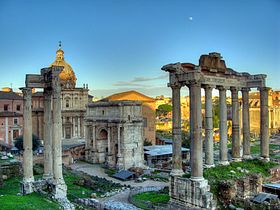




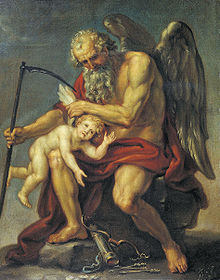




.jpg)


.jpg)
